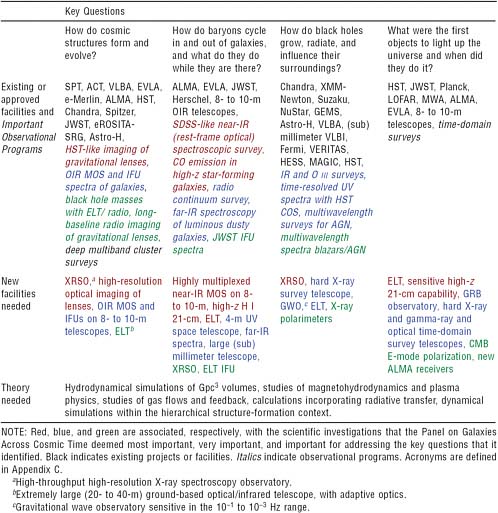3
Report of the Panel on Galaxies Across Cosmic Time
I get wisdom day and night
Turning darkness into light.
—St. Paul Irish Codex, translated by Robin Flower
SUMMARY
The study of galaxies across cosmic time encompasses the main constituents of the universe across 90 percent of its history, from the formation and evolution of structures such as galaxies, clusters of galaxies, and the “cosmic web” of intergalactic matter, to the stars, gas, dust, supermassive black holes, and dark matter of which they are composed. Matter accretes into galaxies, stars form and evolve, black holes grow, supernovae and active galactic nuclei expel matter and energy into the intergalactic medium (IGM), galaxies collide and merge—and what seemed a static world of island universes only a few decades ago turns out to be a lively dance of ever-changing elements. Across all epochs, these processes are coupled in a complicated evolutionary progression, from the relatively smooth, cold universe at high redshift (z > 40 or so) to the highly structured cosmos of galaxies and intergalactic matter today.
The Astro2010 Science Frontiers Panel on Galaxies Across Cosmic Time began its deliberations by reading the extensive set of white papers submitted by the astronomical community to the National Research Council (NRC) at the request of the Committee for a Decadal Survey of Astronomy and Astrophysics. The panel reviewed the substantial advances in the understanding of galaxy and structure evolution that have occurred over the past decade or two. It then identified the four key questions and one discovery area that it believes will form the focus for research in the coming decade:
-
How do cosmic structures form and evolve?
-
How do baryons cycle in and out of galaxies, and what do they do while they are there?
-
How do black holes grow, radiate, and influence their surroundings?
-
What were the first objects to light up the universe and when did they do it?
-
Unusual discovery potential: the epoch of reionization.
To maximize progress in addressing these issues, the panel considered the wide array of observational and theoretical programs made possible by current or future facilities. Observational programs were discussed in sufficient detail to allow an understanding of the requirements (numbers of objects, sensitivity, area, spatial resolution, energy resolution, etc.) so that this panel could provide the most useful input to the study’s Program Prioritization Panels (PPPs; see the Preface for further information on this process); however, any assessment of the suitability of existing or proposed facilities to the key science issues outlined here is left to the PPPs and the survey committee.
This report describes the scientific context for the area “galaxies across cosmic time,” and identifies the key science questions in this area for the next decade and a set of science programs—observational and theoretical—that will answer the most important questions in the field. Some of these programs would require new observational facilities, whereas others could be done with existing facilities, possibly with a reprogramming of resources. In order to provide more useful input to the Astronomy and Astrophysics 2010 (Astro2010) Survey, the top science programs selected by the panel for purposes of this report are identified in three categories: most important, very important, and important. The panel considered many other programs that were eventually excluded from its list but that remain valuable ways to make progress, and it anticipates that significant progress will also come from unexpected directions.
This Summary addresses each of the four key questions in turn, listing only the programs ranked “most important,” plus those “very important” activities that represent unique capabilities. The full set of the panel’s top-ranked science programs is summarized in Table 3.1 at the end of this “Summary” section and is presented with rankings and further details in the body of the report.
How Do Cosmic Structures Form and Evolve?
The answer to this question starts with an understanding of the structure of dark matter halos on all scales. The now-standard lambda cold dark matter—ΛCDM—cosmology provides a detailed foundation on which a theory of galaxy formation and evolution can be built and which in turn can be tested by data.
ΛCDM does seem to be validated on the largest scales of the cosmic web and superclusters, but some of its predictions seem to deviate seriously from observations on smaller scales, from clusters of galaxies, down to galaxies themselves. Specifically, theory predicts that, even after small clumps of dark matter have merged to form ever-larger structures, many of the small clumps should survive intact, embedded within the merged halos. Yet observations appear to indicate that the dark matter in halos is much less “lumpy” than predicted by the straightforward calculations. Direct constraints on the dark matter distribution can be derived from observations of gravitational lenses, both weak and strong. The panel therefore concluded:
-
It is most important to obtain Hubble Space Telescope (HST)-like imaging to determine the morphologies, sizes, density profiles, and substructure of dark matter, on scales from galaxies to clusters, by means of weak and strong gravitational lensing, in lens samples at least an order-of-magnitude larger than currently available. HST can make an important start on this problem, but to develop large statistical samples will require a much larger field of view or more observing time than HST affords.
The best current calculations of cluster formation suggest that gas in the densest regions should cool more than is observed, and that more stars should form in cluster cores, especially in the richest clusters. Perhaps the physical processes that affect baryons in clusters need to be better understood, or perhaps extra energy is injected from supernovae, an active nucleus, or some other source. One critical missing piece of information concerns the dynamics of the hot intracluster gas: how turbulent is the gas, how does it flow through the cluster, what is its ionization and velocity structure, and how do these properties depend on cluster richness and cosmic epoch (redshift)? The panel concluded:
-
High-energy-resolution, high-throughput X-ray spectroscopic studies of groups and clusters to z ~ 2 are most important for understanding the dynamics, ionization and temperature structure, and metallicity of the hot intracluster gas, as well as for studying the growth of structure and the evolution of correlations among cluster properties.
Much is still not known about how galaxies were assembled. The well-defined correlations observed among the shapes, sizes, velocity structures, and compositions of galaxies, observed mainly in the local universe, are poorly understood. A Sloan Digital Sky Survey (SDSS)-size spectroscopic survey at z ~ 1-3 would provide essential information about the evolution of galaxy correlations and should provide essential clues to the process of galaxy formation and evolution. The panel concluded:
-
It is very important to obtain moderate-resolution multi-slit spectroscopy of SDSS-size galaxy samples at z ~ 1-3, in the optical for z < 1.5, and in the near-infrared (IR) for z > 1.5 (with resolution [R] ~ 5,000 to allow effective removal of night skylines in the near-IR). For a representative subset of hundreds of galaxies, high-angular-resolution integral field unit (IFU)1 spectroscopy in the optical or near-IR would help calibrate the slit spectra. To select targets for spectroscopy requires optical/IR pre-imaging over a large area.
How Do Baryons Cycle in and out of Galaxies and What Do They Do While They Are There?
Along with galaxies, clusters, and dark matter, diffuse baryonic gas is a key part of the cosmic web; indeed, it represents most of the baryonic mass in the universe. The metal enrichment of the gas indicates that a great deal of it was processed through stars in the past, yet little is understood about how galaxies acquire gas across cosmic time, convert it to stars, and eject it back into the IGM. To understand this process will require the kind of detailed study of galaxies in the young universe that was done for the local universe with large surveys such as the SDSS and the Two-degree Field Galaxy Redshift Survey.
To create a full evolutionary picture for galaxies, study of the following is needed: the star-formation rate, active galactic nucleus (AGN) activity, starformation history, stellar mass, and stellar and gas-phase metallicity in galaxies at z ~ 1-3, when cosmic star formation and black hole growth rates peaked. By quantifying the correlations of these properties with one another and with the larger-scale environment, astronomers can trace the evolution of galaxies and the baryons within them from the galaxies’ origins to the present day. These detailed galaxy properties are accessible through rest-frame optical spectra that have sufficient resolution to measure dynamical and stellar population parameters, sufficient continuum sensitivity to measure absorption lines, and sufficient emission-line sensitivity to measure low levels of star formation (see Figure 3.13 below in this report). The galaxy samples must be large enough to disentangle the covariances among galaxy properties such as luminosity, mass, age, morphology, and metallicity, over volumes large enough to sample representative galaxy environments. A wide-area survey would trace luminous galaxies, while a smaller-volume survey could probe deeper in order to study the fainter progenitors of typical galaxies today.
To develop a complete view of galaxies in the peak epoch of galaxy formation, comparable to the understanding of galaxies in the local universe, the panel concluded:
-
It is most important to carry out an SDSS-size near-infrared spectroscopic survey of galaxies at 1 < z < 3 using multiobject spectrographs. This will require near-infrared advance imaging in the J, H, and K bands (at 1, 1.6, and 2 microns) to select targets for spectroscopy. Properly designed, the same large near-IR spectroscopic survey could serve the first key question as well.
To probe baryons when they are in and around and between galaxies, one can use absorption spectra of background sources along lines of sight passing near galaxies. Such techniques probe both the gas distribution and its velocity field and will yield insights into gas accretion, outflows, chemical enrichment, and the overall cycle of matter between galaxies and the IGM. Theoretical simulations will be critical for connecting such one-dimensional probes to the three-dimensional gas distribution. At z < 1.5, the principal absorption lines of gas outflowing from galaxies and quasars are in the ultraviolet (UV). UV absorption-line spectroscopy also provides an alternative to X-rays in searching for the “missing baryons” thought to comprise a warm-hot intergalactic medium (WHIM). It may also be possible to image the WHIM directly using IFUs in the UV. The panel therefore concluded:
-
It is most important to use extremely large optical/infrared telescopes (ELTs) to map metal- and hydrogen-line absorption from circumgalactic and dense filamentary intergalactic gas, at moderate resolution toward background galaxies and at higher resolution toward background quasars.
-
A 4-meter-class, UV-optimized space telescope, equipped with a high-resolution spectrograph and an IFU for spectral mapping, is very important for characterizing outflows from galaxies and AGN at z < 1.5 and for mapping the WHIM.
A complete inventory of cold gas in and around galaxies is also crucial for understanding baryon cycling. Molecular gas traced by carbon monoxide (CO), neutral carbon atoms (C I), and higher-density probes provides the raw material for star formation. Neutral atomic gas in the circumgalactic medium likely feeds the growth of galaxy mass. Direct observations of cold gas will make it possible to test theoretical models for complex gas physics and predictions for the evolution of gas content. For the construction of a seamless picture of how gas is processed into stars during the epoch 1 < z < 3, when roughly half of the stellar mass in the universe was formed, a complete inventory of cold gas in and around galaxies is needed. The panel therefore concluded:
-
It is most important to detect CO emission from a representative sample of typical star-forming galaxies from z ~ 1-3, to develop technology for faster spec-
-
troscopic follow-up in the (sub)millimeter, and to develop large-collecting-area facilities to study neutral hydrogen (H I) in emission at z ~ 1-3.
Accurately characterizing star formation that is obscured by dust is critical for obtaining a complete view of baryon processing during the epoch of galaxy formation. Complementing z ~ 1-3 rest-frame optical spectroscopy with radio and submillimeter imaging, as well as far-IR spectroscopy of the dustiest systems, would provide a complete synthesis. The panel concluded:
-
It is very important to do sensitive radio and (sub)millimeter continuum mapping over large areas, preferably coincident with a near-IR (rest-frame optical) spectroscopic survey such as the one described above, and to carry out far-IR spectroscopy of luminous dusty galaxies.
How Do Black Holes Grow, Radiate, and Influence Their Surroundings?
Supermassive black holes (SMBHs), a prediction of Einstein’s general theory of relativity, are ubiquitous within our galaxy and throughout the universe. Observations over the past decade suggest that they play an important role in the evolution of galaxies and clusters. It is still uncertain how and when these black holes form, grow, produce relativistic jets, and feed energy back into the environment. The strong correlation between black hole mass and galaxy mass hints at tightly coupled coevolution and possibly a strong regulatory effect of one on the other. In galaxy clusters, there is equally intriguing evidence that energy liberated by accreting black holes—carried by jets or winds—regulates the thermal evolution of the intracluster gas.
Gas swirling into SMBHs in luminous AGN apparently forms a nearly Keplerian, thin accretion disk, much as predicted more than 30 years ago. X-rays reflected from the disk are imprinted with spectral signatures that encode the dynamical state of the gas and the relativistic curvature of space-time around the black hole. Coupled with sophisticated computer simulations, these signatures can be used to probe the physics of black holes and accretion disks directly and to determine the spin distribution function of the local SMBH population. The structure of AGN accretion disks and jets can also be explored through X-ray polarization measurements.
To understand the details of accretion onto supermassive black holes, jet formation, and energy dissipation, the panel concluded:
-
It is most important to have sensitive X-ray spectroscopy of actively accreting black holes (AGN) to probe accretion disk and jet physics close to the black hole as well as to determine the spin distribution function of the local SMBH population. The effective area should be sufficient to detect the iron Kα emission line on
-
dynamical timescales in a modest sample of the brightest AGN, yielding both spin and mass. To disentangle the effects of absorption in AGN spectra, high resolution (R > 2,000) is required. The same capabilities will yield time-averaged line profiles of more than a hundred AGN with sufficient signal-to-noise ratios to derive the black hole spin distribution.
Most of the evidence for black hole feedback into the intracluster medium (ICM) is either morphological or based on low-spectral-resolution temperature measurements. But since such feedback is thought to occur primarily by way of the kinetic energy of jets and winds, kinematic measurements would provide a more direct test. High-throughput, high-resolution X-ray spectroscopy will reveal bulk motions and turbulence in the ICM, allowing the AGN/ICM coupling to be explored. In order to seek evidence of black hole feedback, the panel concluded:
-
It is most important to measure turbulence and/or bulk flows using X-ray imaging spectroscopy of the ICM of nearby galaxy clusters and groups, with sufficient image quality, field of view, energy resolution, and signal to noise to provide ionization and velocity maps on the scale of the interaction between the AGN outflow (e.g., radio source) and the gas.
A census of black holes across cosmic time is fundamentally important for understanding when and how black holes formed and grew and for assessing whether the energy liberated is adequate to the feedback task. Various multiwavelength survey techniques have been effective at sampling large fractions of the SMBH population, although no one technique yields a full census. Hard X-rays are most directly connected to the energy-generation mechanism in AGN and penetrate all but the highest line-of-sight column densities; IR observations effectively capture radiation reprocessed by dust; optical narrow-line surveys find faint AGN, even when heavily obscured; and radio surveys are completely insensitive to obscuration and can readily detect jets. The panel concluded:
-
It is very important to do complementary multiwavelength surveys to track the growth of black holes across cosmic time. A hard X-ray, all-sky survey for AGN is an essential complement to the deep pencil-beam surveys of active galaxies expected from the upcoming NuSTAR Explorer. Long-wavelength IR surveys capture the total energy output, and rest-frame optical spectroscopic surveys allow black hole mass determinations.
The next decade offers the prospect of detecting gravitational radiation from merging SMBHs in the 105 to 107MSun range out to z ~ 10. While the restricted mass range and the possibility of small-number statistics will prevent a detailed
reconstruction of the SMBH merger tree, such observations can discriminate between small- and large-seed scenarios for early SMBH growth and determine the masses and spins of some objects. The panel concluded:
-
The search for gravitational radiation from merging supermassive black holes, at lower frequencies than are probed with the Laser Interferometer Gravity Observatory, is very important for an understanding of the buildup of supermassive black holes.
What Were the First Objects to Light Up the Universe and When Did They Do It? —and Discovery Area: The Epoch of Reionization
Concerning the first objects to light up the universe, when and where did these objects form? When did the first galaxies emerge and what were they like? How was the universe reionized? This very early phase of galaxy evolution occurred during the epoch of reionization, which the panel designates as its discovery area because of its great discovery potential. This epoch lies at the frontier of astronomy and astrophysics for the next decade.
The first objects to light up the universe could be stars, black holes, galaxies, and/or something less obvious, such as dark matter annihilation. What these objects are and when and where they formed are almost completely unknown. They and subsequent generations provided enough light to reionize the universe by a redshift of z ~ 6, but the topology of the ionization is unconstrained at present. The expectations of astronomers are guided almost entirely by theory.
The first stars should have been essentially metal-free and extremely massive (M > 100 MSun), with a radiation field that is very efficient at ionizing hydrogen and helium. For redshifts z < 11, key emission features will appear in the J band. While individual stars will be much too faint (AB ~ 38-40) to be detected directly with the James Webb Space Telescope (JWST) or an ELT, aggregates of stars may be visible in JWST deep fields, especially with the aid of gravitational lensing. Hypernovae and/or gamma-ray bursts (GRBs), which may be the first individual stellar objects to be observed, can be found through time-domain surveys. GRBs can be used as a probe of the high-redshift intergalactic medium provided that several dozen with z > 8 are detected; this would take several years for a facility with an order-of-magnitude-higher detection rate (which depends on the product of field of view and sensitivity) than is possible with the Swift satellite.
To find and characterize the first-generation aggregates of stars, the panel concluded:
-
It is most important to use JWST to make deep surveys, followed up with near-IR spectroscopy on an ELT.
-
It is very important to develop a next-generation GRB observatory to search for the first explosions, with an order-of-magnitude-greater GRB detection rate than is possible with Swift, augmented by a rapid follow-up capability for infrared spectroscopy of faint objects.
-
It is very important to do time-domain surveys to identify the first stars from their supernova or hypernova explosions.
One of the most tantalizing probes of the epoch of reionization is the redshifted 21-cm H I line. Ionization pockets in the cold intergalactic gas are expected to cause fluctuations in the 21-cm brightness temperature. Existing experiments (e.g., the Low Frequency Array for radio astronomy [LOFAR], the Murchison Widefield Array [MWA]) may be able to detect these fluctuations to z ~ 10. Ultimately, with future large-area low-frequency radio arrays, it should be possible to map the entire history of reionization by means of an all-sky map of redshifted 21-cm emission.
Absorption-line spectroscopy along sightlines toward the first stars, GRBs, or supernovae will allow the detection of the presence of metals and the ionization level throughout the epoch of reionization. Such observations require the collecting area and spectroscopic capability of an ELT.
The panel concluded that to explore the discovery area of the epoch of reionization:
-
It is most important to develop new capabilities to observe redshifted 21-cm H I emission, building on the legacy of current projects and increasing sensitivity and spatial resolution to characterize the topology of the gas at reionization.
-
It is very important to do near-infrared absorption-line spectroscopy with JWST, ELTs, and 10-m-class telescopes to probe the conditions of the IGM during the epoch of reionization.
Although this discussion has so far focused on the first objects, it is very important to find and identify objects residing in the later stages of the epoch of reionization, including radio-loud AGN, quasars, galaxies, supernovae, and GRBs. The panel concluded:
-
It is very important to do multiwavelength surveys to detect galaxies, quasars, and GRBs residing in the late stages of reionization at 6 < z < 8, including near-infrared surveys for galaxies and quasars, hard X-ray or gamma-ray monitoring for GRBs, and time-variability surveys for supernovae or hypernovae.
Theory and Laboratory Astrophysics in the Next Decade
Underlying all of astronomy and astrophysics is critical work in theory and other intellectual infrastructure, such as laboratory astrophysics. Theory is at the heart of astronomical inference, connecting observations to underlying physics within the context of a cohesive physical model. The past decade has seen great advances in theoretical aspects of galaxy formation and black hole astrophysics, particularly in the computational arena, which is driven by technological advances (much as with observations). To understand the universe better, to reap the full value of new observational capabilities as they become available, and to guide the next observations, the panel concludes that investments are needed in the following theoretical areas:
-
Cosmological context. Hydrodynamical simulations within a hierarchical structure-formation context, expanding the dynamic range to study detailed galaxy and cluster assembly within a representative volume.
-
Galactic flows and feedback. Central to galaxy assembly; requires understanding of the associated two-phase interfaces and instabilities as gas moves through the inhomogeneous intergalactic medium and of how energy, momentum, and relativistic particles feed back into ambient gas.
-
Magnetohydrodynamics (MHD) and plasma physics. Studies of how magnetic fields channel and transport energy over a large dynamic range, including developing a better understanding of magnetic reconnection, particle acceleration, and cosmic-ray transport.
-
Radiation processes. Coupling radiative transfer models to dynamical galaxy-formation simulations, and incorporating radiation hydrodynamics and nonthermal processes into models of jets and accretion disks.
Summary of the Panel’s Conclusions
The panel’s conclusions and top-rated science programs are summarized in Table 3.1.
INTRODUCTION
Galaxies are complex systems that evolve dramatically across cosmic time (Figure 3.1). Their critical constituents—not only stars, gas, and dust, but also supermassive black holes and dark matter—are strongly coupled to one another. During the past decade scientists have learned that no galaxy is an island: they constantly influence and are influenced by their environments.
TABLE 3.1 Summary of Conclusions of the Panel on Galaxies Across Cosmic Time
|
|
The understanding of galaxies and galaxy evolution has changed radically over the past two decades, thanks to major advances in instrumentation across the electromagnetic spectrum, leaps in conceptual and computational theory, and innovative observational programs. These exciting advances can be illustrated with just a few recent examples:
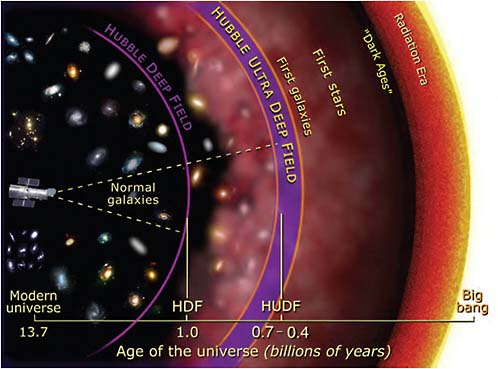
FIGURE 3.1 The universe of galaxies today has developed over the 13.7 billion years since the big bang. Images from the Hubble Space Telescope’s deep surveys extend from the nearby cosmos to the current frontier of the observable universe at z ~ 6, and even beyond in a few fortuitous cases (e.g., when enhanced by gravitational lensing). Detection of the first objects and first structures condensing out of the “Dark Ages” is a key goal for the coming decade. SOURCE: Courtesy of NASA and A. Feild (STScI).
-
Astrophysical objects are now detected out to extraordinarily high redshifts (current record: z ~ 8.2), probably before the universe is fully reionized (see Figure 3.1).
-
Scientists have discovered that most baryons in the universe—and most metals—do not lie in galaxies, implying that galaxy formation is relatively inefficient and/or winds are very important (Figure 3.2).
-
The strong correlation observed between the stellar velocity dispersions in galaxies and the masses of their central black holes—the so-called M-σ relation—indicates that the evolution of galaxies must be closely tied to the growth of supermassive black holes.
-
The simplest theory of galaxy formation predicts that big galaxies should be forming lots of stars, but this is not observed, which in turn has prompted theorists
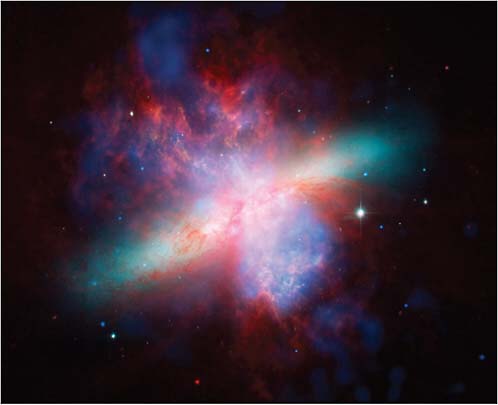
FIGURE 3.2 M82, a starburst galaxy driving a galactic superwind. In similar galaxies at high-redshift, this kind of wind or an active galactic nucleus-driven wind may provide the feedback that inhibits star formation. The galaxy’s stellar disk is shown in yellow-green; orange and red trace ionized gas and dust being driven out of the galaxy by the starburst, and blue indicates gas heated by the outflow to such a high temperature that it emits X-rays. The metals in this wind will enrich the intergalactic medium. SOURCE: X-ray: Courtesy of NASA/CXC/Johns Hopkins University/D. Strickland. Optical: Courtesy of NASA/ESA/STScI/AURA/The Hubble Heritage Team. IR: Courtesy of NASA/JPL-Caltech/University of Arizona/C. Engelbracht.
-
to consider the role of feedback (see Figure 3.2; see also Figure 3.6 in the next section) from AGN and supernovae in galaxy and cluster evolution.
-
For the first time, a quantitative standard model of cosmology—ΛCDM—provides a detailed foundation on which a theory of galaxy formation and evolution can be built and which in turn can be tested by data.
Advances like these are driven by observations across a very broad wavelength range, by surveys and studies of individual objects, by temporal studies, and by theory. In the past decade, large surveys have provided unprecedented statistical coverage of galaxy properties, leading to such breakthroughs as the evidence for
reionization at z > 6 and the quantification of the bimodal distribution of galaxies in mass-color space. Studies of deep fields have changed the understanding of AGN evolution and revealed a population of dust-enshrouded galaxies with high rates of star formation and/or accretion onto black holes. Computational power has reached a level at which large enough volumes of the universe can be simulated to do meaningful statistical studies, address a range of scales in a single calculation, and model increasingly sophisticated physics.
The study of galaxies across cosmic time draws on and informs the subject matter of nearly every major theme in contemporary astrophysics. To connect the current universe with its origins billions of years ago, there must be understanding of how stars formed under conditions ranging from the extremes of density, pressure, and metal abundance that prevailed as galaxies were being assembled, to the conditions typical of present-day galaxies such as the Milky Way. As stars age and die, they enrich the cosmos with heavy elements, and their explosions as supernovae and gamma-ray bursts help probe the cosmos at high redshift. Nearby galaxies demonstrate how to translate distant observables into physical parameters, how galaxies acquire mass from their surroundings, and how they expel mass, energy, and metals into their environments. The evolution of clusters of galaxies and the formation of structure with redshift provide powerful new tools for cosmology, constraining the properties of dark matter and dark energy. Black holes and relativistic jets provide insights into strong gravity, particle acceleration, and perhaps the nature of the highest-energy cosmic rays. Astronomy pushes the envelope of high-performance computing and ties in with the latest developments in areas such as atomic physics, numerical relativity, and plasma physics.
The purview of this Panel on Galaxies Across Cosmic Time encompasses the main constituents of the universe across 90 percent of cosmic time. Overlapping responsibilities with other Astro2010 Science Frontiers Panels—for example, responsibility for the epoch of reionization (with the Panel on Cosmology and Fundamental Physics) or for the study of nearby supermassive black holes (with the Panel on the Galactic Neighborhood)—were resolved in discussions among the panel chairs, taking into account the continuity with the other material considered by each panel. With the Panel on the Galactic Neighborhood, this panel agreed to a fuzzy boundary at z ~ 0.1, but with this panel including within its study supermassive black holes in nearby galaxies (not the Milky Way). With the Panel on Cosmology and Fundamental Physics it was agreed that this panel would focus on astrophysics (e.g., What is the distribution of dark matter?), whereas the Panel on Cosmology and Fundamental Physics would focus on fundamental physics (e.g., What is the dark matter made of?), and that this panel would cover the epoch of reionization.
Many of the cosmic objects of interest to science in the area of galaxies across cosmic time are faint and distant, yet dramatic progress has been made in the past decade in understanding how the components fit together. To set the stage for this
panel’s assessment of the most pressing questions in this field for the next decade, and the observational and theoretical capabilities needed to address them, it is first necessary to summarize the context inherent in present understanding.
Cosmic structures develop against the background of the expanding universe. Simulations show that the ΛCDM model successfully reproduces many of the properties of the universe on large scales (Figure 3.3). The largest structures seen—superclusters of galaxies and the cosmic web of filaments—evolve straightforwardly from tiny quantum fluctuations in the early universe, in a way that agrees well with the predictions of ΛCDM. The amount and distribution of dark matter have also been measured in systems from dwarf galaxies to clusters, and it has been verified that dark matter dominates over normal matter on the largest scales (Figure 3.4).
However, on the small scales of galaxies and for some properties of clusters, the data seem to disagree with the simple ΛCDM predictions. The distribution of baryons—the matter that makes the stars and gas and also collapses to form super-
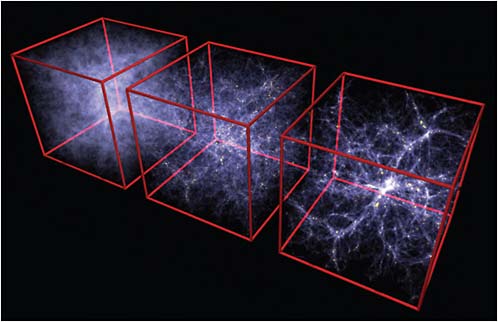
FIGURE 3.3 Simulation showing the evolution of large-scale structure in the universe’s gas component, from redshift z = 6 to 2 to 0 (left to right). Each box is 100 Mpc/h (co-moving) on a side. Locations of galaxies where stars have formed are shown in yellow. The cosmic web of dark matter and gas condenses through gravitational instability, and galaxies form in the overdense regions that trace the underlying large-scale structure. SOURCE: Courtesy of Volker Springel, Heidelberg Institute for Theoretical Studies.
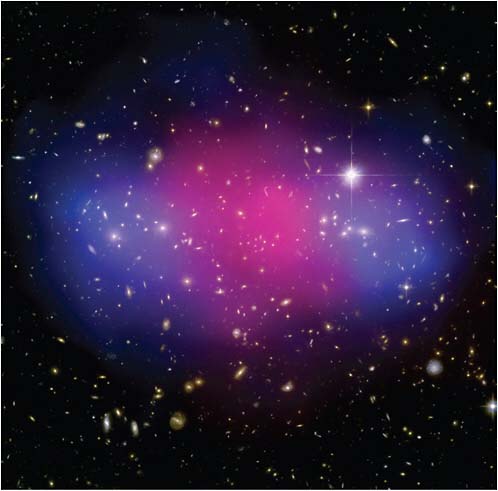
FIGURE 3.4 A composite image of the matter in the galaxy cluster MACSJ0025.4−1222. Individual galaxies are seen in the underlying optical image from the Hubble Space Telescope, the hot X-ray-emitting gas is shown in red, and the dark matter mapped by gravitational lensing is shown in blue. The gas cloud in the center is distorted by the collision between the two clusters, whereas the dark matter has passed through the cluster gas without interacting. The clear separation between gas and dark matter is direct evidence that dark matter exists (as opposed to modified gravity) and that it does not interact with baryonic matter. SOURCE: X-ray: Courtesy of NASA/CXC/Stanford University/S. Allen. Optical/Lensing: Courtesy of NASA/STScI/University of California, Santa Barbara/M. Bradac; see http://www.nasa.gov/mission_pages/chandra/news/08-111.html.
massive black holes at the centers of galaxies—turns out to be more complicated than predicted: if one assumes a simple relationship between the masses of dark matter halos and the luminosities of their galaxies, models of cosmic structure predict the wrong number of galaxies, with the wrong masses and colors, forming at the wrong times. Similarly, clusters of galaxies should show simple scaling relations between, for example, X-ray luminosity and temperature, yet the observations deviate from the predictions. An additional energy source besides gravity—perhaps coming from active galaxies and/or supernovae—appears to be necessary in order to understand cosmic structures, but so far there is little direct observational evidence for this so-called feedback (see, in the next section, Figure 3.7).
The history of star formation plays a crucial role in the evolution of galaxies, clusters of galaxies, and the intergalactic medium. The IGM contains most of the baryons at all epochs and as early as z ~ 6 was enriched with heavy elements that must have been made in stars. Astronomers are just learning how star-formation rates, heavy-element abundances, and galaxy masses change with cosmic time. The preliminary results indicate that the stars in massive galaxies formed when the universe was very young and that these galaxies stopped forming stars many billions of years ago, whereas smaller, less massive galaxies, like the Milky Way, have continued to form stars until the present. Galaxies, at least at z < 0.5, come in a bimodal distribution of mass and color and exhibit relatively simple correlations linking mass, metallicity, and galactic structure.
It has also been learned that supermassive black holes, at least at low redshifts, lie at the centers of virtually all massive galaxies and that there are relatively simple relations between properties of the galaxy—such as its bulge mass and velocity dispersion—and the mass of the black hole. The reasons for these correlations are not understood, nor is it known how these relationships evolve and whether they extend to lower masses. Active galaxies—manifestations of accreting supermassive black holes—were vastly more abundant and luminous in the past: their numbers and integrated luminosity peaked roughly when star formation was at its peak.
Both black hole growth and star formation are implicated in feedback and in the evolution of structures on all scales. Yet the current inventory of these processes is far from complete. Cold gas and dust enshroud many star-forming galaxies and AGN. Roughly half of all the light emitted in the universe has been absorbed by dust and gas and re-emitted in the mid- to far-IR, and hard X-ray surveys with the latest generation of satellites have shown that approximately two-thirds of all AGN are obscured and that these obscured AGN emit most of the energy radiated by supermassive black holes. Infrared and submillimeter studies have revealed that most early star formation occurred behind a thick screen of dust, as exemplified spectacularly by the ultraluminous infrared galaxies that are the most prodigious sites of star formation in the universe (Figure 3.5).
Before the first stars and galaxies formed, the universe was dark. The reioniza-
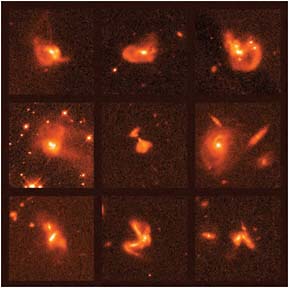
FIGURE 3.5 Hubble Space Telescope images of ultraluminous infrared galaxies make clear that their prodigious star-formation rates are associated with violent mergers of two or even more galaxies. Often these are dusty, obscured environments best imaged at far-infrared or X-ray wavelengths. SOURCE: Courtesy of NASA and K. Borne (Raytheon ITSS and NASA Goddard Space Flight Center), H. Bushouse (STScI), L. Colina (Instituto de Fisica de Cantabria, Spain), and R. Lucas (STScI); see http://hubblesite.org/newscenter/archive/releases/1999/45/image/a/format/web_print/.
tion of the intergalactic medium occurred as the first generations of luminous objects ionized their surroundings, somewhere between redshifts of (very roughly) 6 and 20. Analysis of the cosmic microwave background (CMB) and absorption-line studies of gas along the line of sight to distant quasars and gamma-ray bursts have begun to probe this epoch. But it is still unknown which kinds of objects—stars or quasars, or something else (e.g., decaying dark matter)—ended the cosmic “Dark Ages.” Computer simulations are providing theoretical tools needed to push toward an answer, while upcoming space missions and ground-based instruments, such as the James Webb Space Telescope and the Atacama Large Millimeter Array (ALMA), may provide crucial clues.
Against this background of rapid-fire and unexpected discoveries during the past decade, the panel has identified four questions and one discovery area that are particularly ripe for addressing in the next decade:
-
How do cosmic structures form and evolve?
-
How do baryons cycle in and out of galaxies, and what do they do while they are there?
-
How do black holes grow, radiate, and influence their surroundings?
-
What were the first objects to light up the universe and when did they do it?
-
Unusual discovery potential: The epoch of reionization.
In the following sections, the panel discusses each of these issues and outlines a science program of observations and theory to address them during the coming decade. The program is ambitious: to help make the inevitable hard choices, the panel classifies each approach in one of three categories: as “most important,” “very
important,” or “important.” Many other ideas considered but eventually excluded from the list remain valuable as ways to make progress, and the panel anticipates that significant progress will also come from unexpected directions. The history of astronomy and astrophysics attests that key breakthroughs often come from serendipitous discoveries with broadly capable facilities.
GCT 1. HOW DO COSMIC STRUCTURES FORM AND EVOLVE?
-
What is the structure of dark matter halos on galaxy, group, and cluster scales?
-
What is the origin of the observed correlations among the fundamental properties of galaxies and of clusters, and how do they evolve with time?
Progress to Date
The origin of the cosmic structures seen on different scales throughout the universe depends on the underlying physics. While ΛCDM is validated on large scales, it is not fully understood how luminous structures on smaller scales arise and whether the observed properties of galaxies and clusters are consistent with the cold dark matter cosmology.
The challenges on small scales are significant. In and around galaxies, the dark matter appears to be much less lumpy than predicted, as evidenced by the mismatch between the number of low-mass satellites detected around the Milky Way in the Sloan Digital Sky Survey and the abundance of subhalos predicted by dark matter simulations. The internal mass density profiles of galaxies and clusters appear to deviate from the simple universal shape predicted by theory in the central regions of dark matter halos. Also the limited amount of ongoing star formation in elliptical galaxies, along with the relative abundance of large, fragile disks in the local universe, is not understood in the context of current theory (Figure 3.6).
The origin of the well-defined correlations among the shapes, sizes, and compositions of galaxies and clusters is also not understood. For example, the “fundamental plane” linking properties of elliptical galaxies or the Tully-Fisher relation for spirals, should be predicted by a successful theory of galaxy formation, as should the tight relationship between the mass of the central supermassive black hole and that of the host galaxy, as well as associations among stellar mass, total mass, and chemical composition of galaxies. Similar tight relationships are observed among the properties of clusters: for example, correlations among cluster mass and the luminosity and temperature of the hot intracluster gas. It is not yet understood what processes cause these relations and govern their evolution over cosmic time.
Although there is some information, albeit limited, on the evolution of galaxies out to z ~ 6, scientists are only beginning to glimpse how clusters evolve out to z ~ 1. Comparison with hydrodynamical simulations reveals significant departures
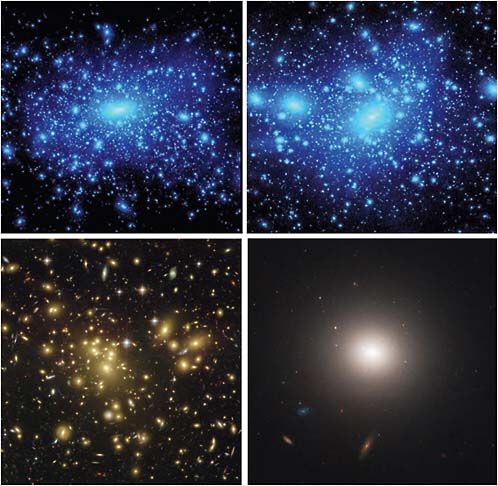
FIGURE 3.6 Top: Simulated cluster-scale (left) and galaxy-scale (right) dark matter halos look quite similar, despite differing in mass by two orders of magnitude. The regions shown are at comparable contrast and resolution and correspond to approximately 2 virial diameters around each halo. Bottom: Hubble Space Telescope images of galaxy cluster Abell 1689 (left) and of galaxy NGC4458 (right). In the actual data, the observed number of satellites is dramatically different for the two observed systems, even though the dark matter substructure is predicted to be virtually indistinguishable. SOURCE: Top: Courtesy of Andrey Kravtsov (University of Chicago), Anatoly Klypin (New Mexico State University), and Stefan Gottloeber (AIP, Potsdam, Germany). Bottom left: Courtesy of NASA, ESA, Richard Ellis (Caltech), Jean-Paul Kneib (Observatoire Midi-Pyrenees, France), A. Fruchter, and the ERO Team (STScI and ST-ECF). Bottom right: Courtesy of NASA, ESA, E. Peng (Peking University, Beijing), and the ACS Virgo Cluster Survey Team.
from theory, underscoring the importance of baryonic physics—including cooling and heating, gas ejection, and turbulence—that have not yet been modeled adequately. For example, recent X-ray spectroscopic studies of supposedly cool cores in the centers of many massive clusters show that the amount of gas cooling is considerably less than simple models predict (Figure 3.7), raising important questions: What prevents these cool cores from cooling further? What does the
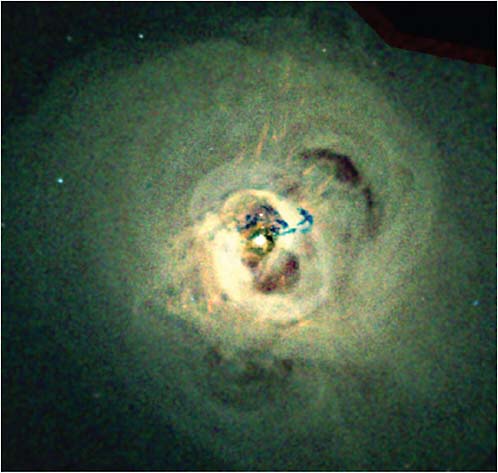
FIGURE 3.7 Chandra X-ray image of the Perseus cluster. Low-density regions are seen as dark bubbles surrounded by bright regions of hot, X-ray-emitting gas, believed to be generated by outbursts of activity from the central black hole. This may be direct evidence for feedback between black hole growth and cluster evolution. SOURCE: Courtesy of NASA/CXC/IoA/A. Fabian et al.
early metal enrichment of the intracluster medium, to ~1/3 solar, reveal about structure formation (as well as baryon cycling)? Understanding the properties of clusters and the ICM will also help improve the understanding of why galaxies in clusters differ from those in the field.
Exploring the observed correlations among galaxy and cluster properties and measuring their evolution with time will provide powerful probes of structure formation and of the complex processes of star formation, metal enrichment, feedback, and radiative cooling that are underway in these systems.
Steps for the Next Decade
Understanding how cosmic structures form and evolve on galaxy, group, and cluster scales starts with studying the dark matter distribution on a range of scales, measuring the characteristics of intracluster gas, and probing the interplay of dark and luminous matter. Here the panel outlines the highest-priority activities for the coming decade, on dark matter substructure, hot gas dynamics, galaxy properties, and black hole masses.
Dark matter substructure and the overall shape of dark matter halos can be probed directly, on both galaxy and cluster scales, through its gravitational lensing effects (Figure 3.8). Large samples of lenses, at least an order-of-magnitude larger than present samples, are required to constrain the mass function of halo substructure, and high spatial resolution (HST-like or better) is needed to detect the lensing signal in the positions and flux ratios of multiple images (in the case of strong lensing). JWST and ELTs with adaptive optics can probe the full range of the mass function using even higher resolution. Detailed imaging and spectroscopic studies of individual objects would reveal the evolution of dark matter profiles over time, through a combination of lensing (weak and strong) and dynamics. In order to determine the mass function of substructure and the profile of the dark matter in galaxies and clusters, the panel concluded:
-
It is most important to obtain HST-like imaging to determine the morphologies, sizes, density profiles, and substructure of dark matter, on scales from galaxies to clusters, by means of weak and strong gravitational lensing, in lens samples at least an order-of-magnitude larger than currently available. HST can make an important start on this problem, but to develop large statistical samples will require a much larger field of view or more observing time than HST affords.
Studies of the evolution of cluster properties are currently limited by small high-redshift samples with a variety of selection biases. Further progress requires uniformly selecting clusters over a wide redshift and mass range using coordinated wide-field X-ray, Sunyaev-Zel’dovich effect (SZE), and optical/infrared (O/IR) sur-
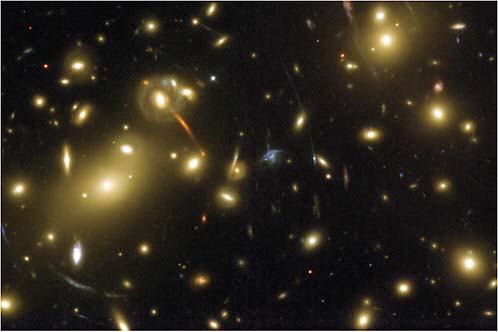
FIGURE 3.8 The gravitational potential of the cluster Abell 2218 (yellowish galaxies) acts as a cosmic lens, bending the light from background sources, magnifying them, and creating multiple and/or distorted images (bluish arcs). The curvature and displacement of the images contain enough information to reconstruct the smooth mass distribution and that associated with cluster galaxies. A gravitational lensing experiment on the smaller scale of galaxies will constrain the dark matter substructure predicted by numerical simulations. SOURCE: Courtesy of NASA, N. Benitez (Johns Hopkins University), T. Broadhurst (Racah Institute of Physics/Hebrew University), H. Ford (Johns Hopkins University), M. Clampin (STScI), G. Hartig (STScI), G. Illingworth (UCO/Lick Observatory), the ACS Science Team, and ESA.
veys (Figure 3.9). Some surveys that can deliver these samples are either operating or appear to be already funded, including SZE surveys with the South Pole Telescope (SPT) and Atacama Cosmology Telescope (ACT) and a future X-ray survey with eROSITA/Spektrum-RG. Both SZE and X-ray surveys require deep multiband (griz) optical surveys, sufficient to detect galaxies a couple of times fainter than the typical galaxy at z = 1 (e.g., the Dark Energy Survey [DES], funded to begin in 2011) to deliver optical confirmation and redshifts to z ~ 1, and near-infrared surveys (e.g., the Visible and Infrared Survey Telescope for Astronomy [VISTA]) pushing to 0.5 L* for clusters at z > 1.
The most critical study of new cluster samples concerns the dynamics of the gas component of clusters, which dominates the baryonic mass and contributes to the
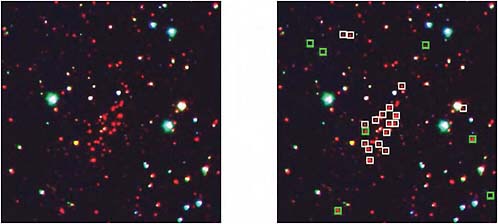
FIGURE 3.9 Massive red-sequence-selected galaxy cluster at z ~ 1.2, detected in an optical/infrared survey. Left: Color composite of the cluster combining Canada-France-Hawaii Telescope Megacam R- and z-band images with Spitzer Infrared Array Camera 3.6-μm images. The cluster of massive, old red galaxies is easily visible. Right: Spectroscopically confirmed cluster members are marked with white squares; background and foreground galaxies are indicated with green circles. The photometric redshifts agree well with the spectroscopic redshifts, validating their use and enabling large surveys for high-redshift clusters; however, the mass of the cluster estimated from the light in the galaxies does not seem to agree with scaling relations from lower-redshift clusters. This color selection technique makes it possible to study cluster evolution out to quite high redshifts. SOURCE: A. Muzzin, G. Wilson, H.K.C. Yee, H. Hoekstra, D. Gilbank, J. Surace, M. Lacy, K. Blindert, S. Majumdar, R. Demarco, J.P. Gardner, M. Gladders, and C. Lonsdale, Spectroscopic confirmation of two massive red-sequence-selected galaxy clusters at z ~ 1.2 in the SpARCS-North Cluster Survey, Astrophysical Journal 698(2):1934-1942, 2009, reproduced by permission of the AAS.
pressure. Very little is known about the velocity or ionization structure of this gas, although it is suspected that turbulence may be a very important source of energy dissipation within it. High-resolution X-ray spectroscopy of cluster gas is the best means of directly measuring the turbulence, bulk flows, and AGN-driven shocks within this gas. The planned Astro-H mission will make the first few measurements of this kind, in the brightest local clusters. Similar observations over a broader range of cluster mass and redshift will allow fresh insights into puzzles such as the excess entropy and heating mechanisms within clusters. Additional information on gas dynamics could come from detailed radio and/or submillimeter mapping of clusters detected at lower resolution by SZE surveys. The panel concluded:
-
High-energy-resolution, high-throughput X-ray spectroscopic studies of groups and clusters to z ~ 2 are most important for understanding the dynamics, ionization and temperature structure, and metallicity of the hot intracluster gas, as
-
well as for studying the growth of structure and the evolution of the correlations among cluster properties.
Clues to the relationship between baryons and dark matter are encoded in correlations among galaxy properties like mass, luminosity, surface brightness, and velocity structure. A great deal has been learned about galaxies in the local universe from large spectroscopic surveys in the rest-frame optical, such as the Sloan Digital Sky Survey, including the bimodal nature of the galaxy color-magnitude distribution. Comparable information at higher redshifts, where most of the star formation occurs, lags well behind; available samples come from deep imaging surveys such as the Great Observatories Origins Deep Survey (GOODS), Deep Extragalactic Evolutionary Probe 2 (DEEP2), or the Cosmological Evolution Survey (COSMOS), which cover at most a few square degrees and for which the spectroscopic follow-up (with single-slit near-IR spectrometers) is very slow and therefore limited.
Considerable progress would result from a near-infrared spectroscopic survey of galaxies at the epoch of peak star formation, 1 < z < 3. With SDSS-size samples, galaxy properties can be sorted by color, mass, redshift, morphology, and age, as was done very effectively at z ~ 0. Spatially resolved spectroscopy of a representative subset, to obtain velocity dispersions and/or rotation curves, would trace the detailed internal velocity fields and help in understanding the slit spectroscopy for the larger sample (Figure 3.10). Currently, substantial samples could be studied with existing large telescopes, using upcoming multiobject near-IR spectrometers with moderate resolution (R ~ few thousand), although a truly SDSS-like survey would require additional resources. The panel concluded:
-
It is very important to obtain moderate-resolution multi-slit spectroscopy of SDSS-size galaxy samples at z ~ 1-3, in the optical for z < 1.5, and in the near-IR for z > 1.5 (with [R] ~ 5,000 to allow effective removal of night skylines in the near-IR). For a representative subset of hundreds of galaxies, high-angular-resolution integral field unit (i.e., two-dimensional) spectroscopy in the optical or near-IR would help calibrate the slit spectra. To select targets for spectroscopy requires optical/IR pre-imaging over a large area. It should be noted that, properly designed, the same large near-IR spectroscopic survey could serve the second key question as well.
Measurements of supermassive black hole masses over the past decade have revealed a remarkable correlation between black hole mass and the stellar kinematics, mass, and luminosity of the galaxy bulge. This was unexpected because it means that stars very far outside the sphere of influence of the black hole somehow “know about” its mass, suggesting that the process of galaxy formation and evolution is closely tied to the growth of the central supermassive black hole. At present, astronomers have few indications of how this might happen, and they are
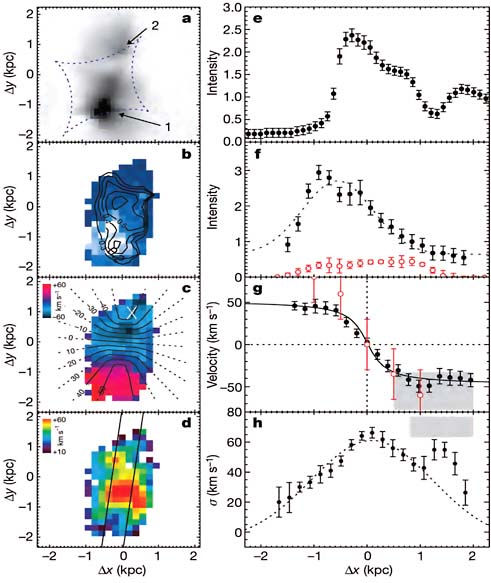
FIGURE 3.10 Integral field unit (IFU) spectroscopy of a gravitationally lensed galaxy at z = 3.07, demonstrating the range of information provided by IFU measurements. All panels are source-plane reconstructions of the lensed galaxy called the Cosmic Eye. With the next generation of ground- and space-based large telescopes, spatial resolution of hundreds of parsecs will be obtained for galaxies at z > 1, enabling the study of spatially resolved continuum (panels a and e) and emission-line (panels b and f) intensities, velocities (panels c and g), and velocity dispersions (panels d and h); the left panels show the two-dimensional galaxy reconstruction, and the right panels show the one-dimensional slit extraction. Such measurements are crucial for determining the overall dynamical state (disk/merger) and detailed kinematic structure of galaxies as they form. Furthermore, mapping the spatially resolved emission from multiple rest-frame optical emission lines will trace out not only the distribution of star-forming regions but also the related gradients in chemical abundances. SOURCE: Reprinted by permission from Macmillan Publishers Ltd.: Nature, D.P. Stark, A.M. Swinbank, R.S. Ellis, S. Dye, I.R. Smail, and J. Richard, The formation and assembly of a typical star-forming galaxy at z ~ 3, Nature 455:775, 2008, copyright 2008.
struggling to obtain reliable black hole mass estimates for more than a few dozen galaxies. Defining this relation over a larger mass range and a broader redshift range would help improve the understanding of the interplay of the stellar assembly and black hole growth. The panel therefore concluded that, in order to extend the M-σ relation to low-mass local systems and massive high-redshift systems:
-
It is important to measure supermassive black hole masses in hundreds or even thousands of systems using spatially resolved spectroscopy with adaptive optics on ELTs, centimeter-wave maser observations with very long baseline arrays supplemented by large aperture dishes, and/or reverberation mapping of AGN. (See similar conclusion for the third key question, GCT 3.)
A precise study of the mass function of substructures on galaxy scales can also be done with radio interferometers, which can image strong galaxy-scale gravitational lenses to constrain the mass distribution within galaxies. Compared to optically imaged lenses, fewer radio lenses are bright enough for this technique, but the spatial resolution is far superior to even optical imaging from space. Because the incidence of lensing rises sharply with increasing spatial resolution, it will eventually be possible to study very large samples of lenses with high-resolution radio imaging, with sensitive facilities that survey a large fraction of the sky. This kind of study can start now with existing and/or upgraded radio facilities and will reach truly powerful levels with future facilities. The panel concluded:
-
It is important to obtain Very Long Baseline Array (VLBA), Expanded Very Large Array (EVLA), e-Merlin, and/or ALMA imaging of at least a few hundred new galaxy-scale lenses. The development of a large-collecting-area radio facility that can survey a large fraction of the sky with subarcsecond resolution will increase the number of accessible lenses by several orders of magnitude.
GCT 2. HOW DO BARYONS CYCLE IN AND OUT OF GALAXIES, AND WHAT DO THEY DO WHILE THEY ARE THERE?
-
How do galaxies acquire gas across cosmic time?
-
What processes regulate the conversion of gas to stars as galaxies evolve?
-
How are the chemical elements created and distributed?
-
Where are the baryons as a function of redshift?
Progress to Date
Galaxies grow by obtaining fuel from the intergalactic medium, converting it into stars, and returning gas, heavy elements, and energy back to their surroundings. These baryonic processes are poorly understood: current models fail to re-
produce even basic observed properties of galaxies without invoking many ad hoc parameters. To understand how galaxies form and evolve across cosmic time, it is critical to understand how baryons cycle into, within, and out of galaxies.
There has been a radical change in the understanding of galaxy growth in the past decade, driven by the recognition of its complex dynamics. Much of this progress has been obtained by optical measures of distant star formation, near-infrared measures of stellar-mass growth, submillimeter measures of dust-enshrouded star formation, and radio measures of molecular gas content. These data have yielded cosmic rates of star formation, accretion, and enrichment during the heyday of cosmic star formation at 1 < z < 3, at least for the brightest galaxies, which appear to be quite different from today’s systems. These bright galaxies are forming stars much more vigorously, are more compact and gas-rich, and are ubiquitously expelling gas. Studying this epoch is crucial, since many properties of present-day galaxies were established at that time.
While typical galaxies are expected to grow mainly by accreting material from the IGM, mergers are probably important for morphological transformations and central black hole growth and may drive the most powerful episodes of early star formation. Quantitatively characterizing the role of gas inflows and mergers in the evolution of galaxies is important for understanding galaxy growth (Figure 3.11).
The IGM holds key signatures of baryon cycling. Not only is it a repository of gas for accretion, but it also contains heavy elements expelled by galaxies. The mass and energy associated with outflows help to modulate star formation and chemical enrichment in galaxies. The cosmic distribution of metals, from diffuse intergalactic gas to intracluster gas to galaxies, provides crucial constraints on baryon cycling. A complete census of cosmic baryons and metals, including those in difficult-to-detect phases such as the warm-hot intergalactic medium (105 < T < 107 K), is important for connecting all of these data. Indeed, galaxies, their halos, and the IGM must be viewed as forming an interconnected cosmic ecosystem within which galaxies form, grow, and die.
Steps for the Next Decade
Two key constituents of galaxies are stars and gas. In the next decade, astronomers are poised to make dramatic advances that will, for the first time, comprehensively trace the evolution of stars and gas within and around galaxies over the majority of cosmic time. This will involve technological developments such as improved near-IR detectors, increased far-IR and radio sensitivities, higher efficiency and spectral resolution in the UV and X-ray, along with anticipated new data from EVLA, Herschel, JWST, and ALMA. Sophisticated numerical simulations will be critical for providing physical insight and enabling observations to be synthesized into a cosmological framework.

FIGURE 3.11 Computer simulation illustrating cold-mode accretion—namely, accretion from the intergalactic medium in which the material remains well below the virial temperature through the virial radius—into a large galaxy at redshift z = 2. Owing to the high cosmic gas density in the early universe and the density enhancement provided by filamentary structure, cold-mode accretion is expected to dominate the global accretion budget during the peak epoch of cosmic star formation. Understanding this fundamental mode of galaxy growth is a key motivation for spectroscopically characterizing the young universe at z ~ 1-3. SOURCE: Reprinted with Davé, and D.H. Weinberg, Galaxies in a simulated permission from D. Kereš, N. Katz, M. Fardal, R. Lambda-CDM Universe. I: Cold mode and hot cores, Monthly Notices of the Royal Astronomical Society 395:160-179, 2009, copyright 2009 Royal Astronomical Society.
Building on the comprehensive view of galaxies at z ~ 0 afforded by the SDSS survey (Figure 3.12) a full evolutionary picture for galaxies calls for comparable rest-frame optical spectroscopy of galaxies and intergalactic gas during the peak epoch of galaxy formation, at z ~ 1-3. The rest-frame optical is better than rest-frame UV for probing light from the bulk of the stellar population, and is less sensitive than is redder light to poorly understood late phases of stellar evolution. The sample size should be large enough to disentangle the covariances among galaxy properties such as luminosity, age, morphology, metallicity, mass, redshift, and so on, over a large enough volume to sample a representative range of galaxy environments. Today, only about a hundred z > 1 galaxies have rest-frame optical spectra, and most of these are strongly star-forming objects, so this small sample gives an incomplete and biased picture of the baryonic contents of the galaxy population at early epochs. Furthermore, these spectra typically consist of emission lines, with little or no continuum detected. With improvements in near-IR detector technology, and a factor of approximately 40 to 50 in multiplexing capability (e.g., Multi-Object Spectrometer for Infra-Red Exploration [MOSFIRE], Flamingos II, EMIR2, or other multiobject infrared spectrometers), it should be possible to obtain spectra of roughly a thousand high-redshift galaxies, spanning a broader range of star-formation histories, with present 6- to 10-meter telescopes. However, at least another order of magnitude in sample size is needed to begin to disentangle covariances among the salient suite of galaxy properties and environments; this may be possible with new instrumentation and/or a future reallocation of current telescope resources.
Over smaller areas one could probe substantially below L*, to study the progenitors of typical galaxies today, with sufficient resolution to measure dynamical and stellar population parameters, sufficient continuum sensitivity to measure absorption lines, and sufficient emission-line sensitivity to measure low levels of star formation. From the ground, R ~ 5,000 spectra are required to resolve out infrared skylines. These data would establish the evolution of the distribution functions of star-formation rate, AGN activity, star-formation history, stellar mass, and stellar- and gas-phase metallicity, and would quantify the correlations of these properties with one another and with the large-scale environment across the most active epoch of galaxy formation (Figure 3.13).
Targeted follow-up using ELTs and JWST will be crucial for studying the faintest and highest-redshift objects and for measuring features that are shifted into the thermal infrared. For maximum synergy with ALMA and possible future high-sensitivity H I observations, survey fields would be equatorial or southern. Deep optical and near-IR imaging surveys for target selection over this area are a prerequisite.
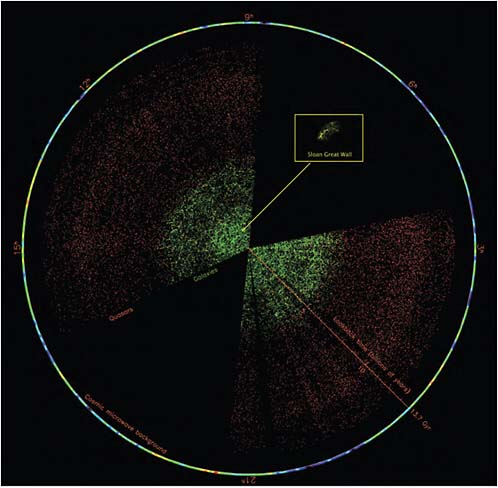
FIGURE 3.12 The large-scale distribution of galaxies (z < ~0.4; green) and quasars (z < ~6.5; red) observed in the Sloan Digital Sky Survey (SDSS) provides a well-sampled view of the local universe, but a much sparser sampling at large distances, during the key epoch of star formation (1 < z < 3, or look-back times of approximately 8 to 11 Gyr). The circular boundary represents the cosmic microwave background at 13.7-Gyr look-back time. An SDSS-size spectroscopic survey at z ~ 1-3 will reveal stellar, gas, and dynamical properties of millions of galaxies in the early universe, at the peak of cosmic star formation and galaxy assembly. SOURCE: W. Colley, J.R. Gott, M. Juric, R.J. Vanderbei, and the SDSS (Sloan Digital Sky Survey) team, to appear in Sizing Up the Universe, by J. Richard Gott and Robert J. Vanderbei, National Geographic.
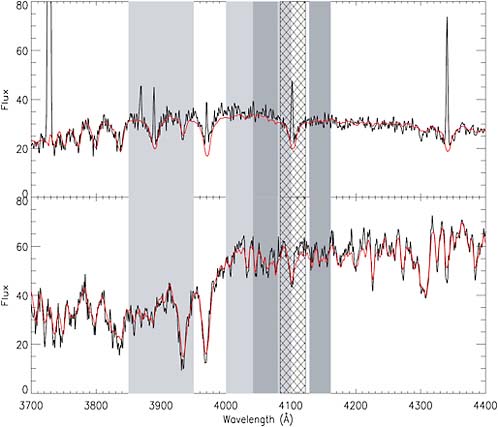
FIGURE 3.13 Constraints on stellar populations and the past history of star formation can be derived from rest-frame optical continuum and absorption-line spectroscopy. Metallicities and dynamical properties are reflected in both rest-frame emission and absorption features. With few exceptions, rest-frame optical spectroscopy for galaxies at z > 1 has been focused on emission-line measurements for the most actively star-forming systems. In the next decade these studies should be extended to more typical systems, tracing both emission and absorption lines for large Sloan Digital Sky Survey (SDSS)-like samples. Shown here are SDSS spectra of a local late-type galaxy (top) and a local early-type galaxy (bottom) plotted over the interval 3,700 to 4,400 Å in the rest frame. The red line shows a best-fitting stellar population model. The shaded regions indicate bandpasses over which indices sensitive to the past history of star formation are measured. The hatched region shows where the Hδ equivalent width is estimated. SOURCE: Reprinted with permission from G. Kauffmann, T.M. Heckman, S.D.M. White, S. Charlot, C. Tremonti, J. Brinchmann, G. Bruzual, E.W. Peng, M. Seibert, M. Bernardi, M. Blanton, et al., Stellar masses and star formation histories for 105 galaxies from the Sloan Digital Sky Survey, Monthly Notices of the Royal Astronomical Society: Letters 341(1):33-53, 2003, copyright 2003 Royal Astronomical Society.
For a representative subsample of galaxies, rest-frame optical IFU spectroscopic maps will be crucial for characterizing the detailed baryonic processes of galaxy assembly, feedback, and chemical enrichment in action. With planned near-IR IFUs on an ELT or the Near-Infrared Spectrometer (NIRSpec) IFU on JWST, it will be possible to map extended warm gas associated with outflows and inflows, as well as
the dynamics probed by higher surface-brightness regions of star formation. Sensitivities to the star-formation rate surface density probed with Hα emission will be roughly an order-of-magnitude higher than is currently possible with 10-meter-class ground-based telescopes. Detailed chemical abundance measurements will require the longest integration times, as they depend on weaker nebular lines.
On the basis of these considerations, the panel concluded that, to understand the full cycling of baryons in and out of galaxies:
-
It is most important to carry out an SDSS-size near-infrared spectroscopic survey of galaxies at 1 < z < 3. This will require near-infrared pre-imaging in the J, H, and K bands (at 1, 1.6, and 2 microns) to select targets for spectroscopy. It should be noted that, properly designed, the same large near-IR spectroscopic survey could serve the first key question as well.
-
It is important to obtain spatially resolved spectroscopy of a representative sample of star-forming galaxies using IFUs on ground-based ELTs and NIRSpec on JWST.
To probe baryons when they are in and around and between galaxies, absorption spectra of background sources along lines of sight passing near galaxies can be used. Such tomographic probes of galaxies and intergalactic gas on transverse scales <1 Mpc from galaxies will yield revolutionary new insights into gas accretion, outflows, chemical enrichment, and the cycle of matter between galaxies and the IGM during the peak epoch of galaxy growth.
Currently, the best-understood transitions for probing inflowing and outflowing diffuse gas lie in the rest-UV, and include transitions of H I, C IV, O VI, and S IV. Until now, the background sources used for high-resolution IGM studies have necessarily been rare bright objects (typically quasars), providing only a sparsely sampled view of the gas around foreground galaxies. In the coming decade, the larger collecting areas of ELTs will open up a new frontier for the study of baryon cycling. At z > 1.5, the key transitions can be probed in the optical, providing a census of baryons and metals around galaxies. High spectral resolution is required to infer accurate ionization conditions for metals and to resolve the photoionized Ly-α forest to the thermal width limit. Yet even with the many faint background sources accessible with ELTs, there will be at most a few galactic absorption systems along any one sight line. Larger samples can be obtained at R ~ 5,000 using typical star-forming galaxies as background probes with much higher surface density.
At redshifts z < 1.5, these same tracers migrate from the optical into the UV. To increase dramatically the sampling density of background probes of warm baryons in the cosmic web requires the development of a 4-meter-class UV telescope with high-resolution spectroscopic capabilities, which can access significantly fainter quasars and galaxies than is currently feasible with HST/Cosmic Origins Spectro-
graph. Such a facility would help provide a comprehensive view of baryons around galaxies, groups, clusters, and in filaments out to z ~ 1.5.
At the present epoch, a large fraction of baryons is thought to be shock-heated and in the WHIM, the bulk of which is best traced by soft X-ray absorption lines. Greater collecting areas in the X-ray are needed to obtain a statistical sample (approximately 100) of background sources for absorption studies of oxygen (O VII, O VIII) and carbon (C V, C VI).
A new and potentially ground-breaking area of study consists of mapping the metal and hydrogen-line emission from circumgalactic and dense filamentary intergalactic gas, using IFUs in the UV. Such observations will provide direct information about the kinematics, density, and chemical content of baryons cycling between galaxies and the IGM.
In short, absorption-line tomography toward background galaxies and quasars and direct emission-line imaging can yield unprecedented information about the kinematics, density, and chemical content of baryons cycling between galaxies and the IGM. Simulations will be critical for connecting such one-dimensional probes to the three-dimensional gas distribution. The panel concluded:
-
It is most important to use ELTs to map metal- and hydrogen-line absorption in circumgalactic and dense filamentary intergalactic gas, at moderate resolution toward background galaxies and at higher resolution toward background quasars.
-
A 4-meter-class UV-optimized space telescope, equipped with a high-resolution spectrograph and an IFU for spectral mapping, is very important for characterizing outflows from galaxies and AGN at z < 1.5 and for mapping the WHIM.
-
It is important to obtain moderate-resolution soft-X-ray spectra for approximately 100 quasar sightlines.
A complete inventory of cold gas in and around galaxies is also crucial for understanding baryon cycling. Molecular gas traced by CO, C I, and higher-density probes provides the raw material for star formation. Neutral atomic gas in the circumgalactic medium likely feeds the growth of galaxy mass. Direct observations of cold gas will make it possible to test theoretical models for complex gas physics and predictions for the evolution of gas content, and will permit the extension of empirical scaling relations (such as the Schmidt-Kennicutt relation) to high redshifts. These data will allow the construction of an accurate picture of how gas is processed into stars during the epoch 1 < z < 3, when roughly half of the stellar mass in the universe was formed.
Facilities coming online in the next decade will enable major advances toward a cosmic census of cold gas. Continuous frequency coverage and wide bandwidths
below 50 GHz (EVLA) and above 84 GHz (baseline ALMA) will make it possible to map the same molecular emission lines in different galaxies across broad, albeit incomplete, ranges in redshift. Baseline ALMA could determine molecular gas masses for a representative sample of several hundred typical star-forming galaxies at z ~ 1-3. These data would provide a dramatic improvement in sample size and breadth over the approximately 60 highly luminous or lensed objects at z > 1 that have been detected in molecular gas with current facilities (Figure 3.14).
There are two additional priorities for investment over the next decade. The first is the need for faster (sub)millimeter spectroscopic follow-up of large samples with sparse sky distributions relative to the typical interferometer fields of view; this could be achieved by equipping interferometers or large single-dish telescopes
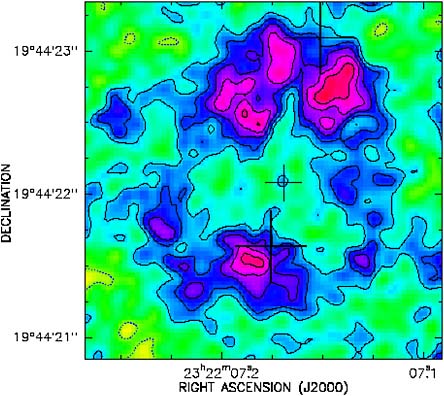
FIGURE 3.14 High-resolution (0.3″) Very Large Array map of CO (J = 2→1) emission from the z = 4.12 quasar PSS J2322+1944, tracing cold molecular gas in its host galaxy. Gravitational lensing into a full Einstein ring makes this system easier to detect and map. The new capabilities of the Expanded Very Large Array and the Atacama Large Millimeter Array will make it possible to extend such work to wider ranges in redshift and to target more typical high-redshift galaxies that are neither extremely luminous nor highly lensed. SOURCE: D.A. Riechers, F. Walter, B.J. Brewer, C.L. Carilli, G.F. Lewis, F. Bertoldi, and P. Cox, A molecular Einstein ring at z = 4.12: Imaging the dynamics of a quasar host galaxy through a cosmic lens, Astrophysical Journal 686(2):851, 2008, reproduced by permission of the AAS.
with multiobject spectroscopic capability. The resulting observations would allow more efficient detection of emission lines from the obscured galaxies detected in large continuum surveys and would help reduce the orders-of-magnitude discrepancy between the large spectroscopic sample sizes for high-redshift galaxies in the optical and those in the radio, which is a major impediment to synthesizing a full picture of baryon cycling.
The other priority is to work toward large-collecting-area facilities that can detect H I emission at z > 0.4 by means of the 21-cm line. Enhancing the low-frequency performance of existing interferometers (to reach z ~ 0.8 in emission) may be a fruitful initial step in this direction. For studying neutral gas in galaxies and the cosmic web, the key frequency range for comparison with studies at other wavelengths and theoretical models of cold accretion will be 200 to 500 MHz (corresponding to z = 2 ~ 6 for the 21-cm line). At z ~ 3, substantially larger collecting areas than those of current facilities will allow for the detection of H I masses comparable to that of the Milky Way, an ambitious but essential long-term goal. For starting an inventory of cold gas in and around galaxies, the panel concluded:
-
It is most important to detect CO emission from a representative sample of typical star-forming galaxies from z ~ 1-3, to develop technology for faster spectroscopic follow-up in the (sub)millimeter, and to develop large-collecting-area facilities to study H I in emission at z ~ 1-3.
The majority of star formation at 1 < z < 3 is obscured by dust, and hence accurately characterizing reprocessed emission is critical to obtaining a full view of star formation across cosmic time. To probe obscured star formation, deep and wide surveys at radio and submillimeter wavelengths are essential; with its new correlator, the EVLA will offer substantial gains in continuum sensitivity in the early part of the next decade. These could be complemented by surveys in the far-IR and (sub)millimeter with apertures large enough to probe below the confusion limits of today’s facilities, and push down to the lower flux densities at which star-forming galaxies selected at other wavelengths are expected to appear. (Sub)millimeter mapping of deep spectroscopic survey fields, in two or more submillimeter bands to minimize biases in dust temperature and redshift, would significantly enhance the understanding of early gas processing. For the most luminous and obscured sources, far-infrared spectroscopy could be used to break the degeneracy between the contributions of star formation and black hole accretion to the bolometric luminosity. The panel concluded:
-
It is very important to do sensitive radio and (sub)millimeter continuum mapping over large areas, preferably coincident with a near-IR (rest-frame optical) spectroscopic survey such as the one described above, and to carry out far-IR spectroscopy of luminous dusty galaxies.
GCT 3. HOW DO BLACK HOLES GROW, RADIATE, AND INFLUENCE THEIR SURROUNDINGS?
-
How do black holes grow over cosmic time?
-
How do the quantity and form of energy production in accreting systems depend on black hole mass, accretion rate, and spin?
-
How does black hole feedback shape the evolution of cosmic structures?
Progress to Date
Supermassive black holes appear to play a unique—and surprising—role in shaping the structure and evolution of galaxies and clusters. If the basic idea of AGN feedback is borne out, it represents a truly remarkable example of multiscale physics—an object a few light-minutes across influencing structure hundreds of thousands of light-years in extent. The central engines of AGN are also interesting in their own right, providing a rare window into the physics of strong gravity and high-energy particle acceleration.
Accretion onto black holes liberates gravitational energy and may also tap energy stored as black hole spin. The energy can be released in various forms, including radiation from an accretion disk and the ejection of powerful jets of relativistic plasma (Figure 3.15).
The past decade has seen dramatic advances in both observational and theoretical studies of the accretion and jet-formation processes. X-ray studies have revealed spectral features originating close to the black hole event horizon. These broad iron lines confirm the presence of thin accretion disks; measuring their profiles has led to the first indications of black hole spin. This places astronomers at the threshold of being able to correlate black hole spin with other fundamental properties, such as the power of relativistic jets, as well as to use spin as a probe of the evolutionary history of SMBHs. X-ray absorption spectroscopy has led to the identification of high-velocity, high-ionization accretion disk winds with mass flow comparable to or greater than the mass accretion rate onto the black hole. Multi-epoch interferometric radio observations have imaged AGN jets with spatial resolutions down to a few tens of Schwarzschild radii, allowing observers to watch ejection events evolving along the jet in real time (Figure 3.16). New ground- and space-based X- and gamma-ray observatories promise to deliver fresh insights into the processes of particle acceleration by AGN and the structure and energy content of AGN jets.
On the theoretical side, the past decade has seen a significant deepening in understanding of the mechanism of accretion disks, in part from fully general relativistic MHD simulations of disks based on first principles. These simulations have progressed to the point of including the jet-launching region around rapidly rotating black holes (see Figure 3.15).
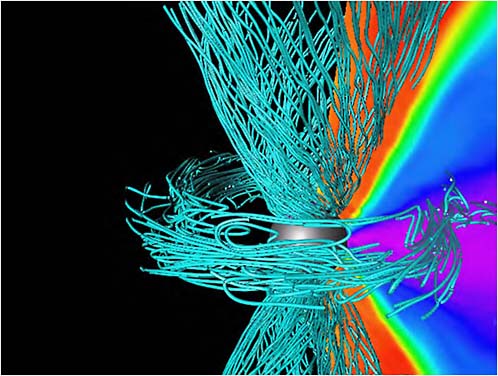
FIGURE 3.15 Illustration of the cross section of a black hole accretion disk from a global hydrodynamical simulation (colors) with magnetic field lines (shown in light blue) threading the black hole. SOURCE: Courtesy of S. Hirose, Japan Agency for Marine-Earth Science and Technology; J.H. Krolik, Johns Hopkins University; J.-P. De Villiers, University of Alberta; J.F. Hawley, University of Virginia; and Richard Sword, University of Cambridge, Institute of Astronomy.
There has been remarkable progress in the development of knowledge of black hole demographics over the past decade. For AGN, this is principally due to deep panchromatic surveys from the radio to the X-ray. These new data have made clear that the majority of accretion occurs in obscured AGN, in which lines of sight are blocked by high column densities of dust and gas that extinguish much of the optical, UV, and soft X-ray radiation and reprocess it into the infrared. It is now known that the first quasars appeared before a redshift of z ~ 6 and that SMBHs are present at the centers of massive galaxies.
There is evidence that the injection of momentum, mass, and energy from SMBHs plays a role in the development of structure on galactic and cluster scales.
![FIGURE 3.16 Top: Radio images of the galaxy M87 at different scales show (top left, Very Large Array [VLA]) giant, bubble-like structures of radio emission powered by the jets from the galaxy’s central black hole and (top right) Very Long Baseline Array image of the jet being formed into a narrow beam within a hundred Schwarzschild radii of the black hole. The scale of each image is shown by white bars; 1,000 light-years is about 60 million times the distance from Earth to the Sun, and 0.1 light-year is about 1,000 Schwarzschild radii for M87’s black hole mass of . Bottom: Hubble Space Telescope (HST) optical image of the quasar 3C 273 and its kiloparsec-scale jet (bottom left) and a multiwavelength Chandra/HST/Spitzer/VLA image of the jet alone (bottom right). The jet emission is synchrotron radiation from energetic electrons accelerated by the jet’s magnetic field, and extends nearly 40,000 light-years across the sky. The highest-energy particles, which radiate X-rays (blue), lose their energy quickly, whereas the lower-energy electrons that radiate optical (green), infrared (red), or radio (yellow) light persist to the end of the jet. Unresolved gamma-ray emission is also detected (e.g., with the Fermi gamma-ray space observatory) from these and other active galactic nuclei and is important for understanding the kinetic energy of jets. Calculating the electron energy from modeling the emission constrains the jet power, which is essential to understanding jet formation and propagation. SOURCE: Top: Courtesy of NASA, National Radio Astronomy Observatory/National Science Foundation, John Biretta (STScI/Johns Hopkins University), and Associated Universities, Inc. Bottom left: Courtesy of NASA/STScI. Bottom right: NASA/JPL-Caltech/Yale University.](/openbook/12982/xhtml/images/p2001dcd6g133001.jpg)
FIGURE 3.16 Top: Radio images of the galaxy M87 at different scales show (top left, Very Large Array [VLA]) giant, bubble-like structures of radio emission powered by the jets from the galaxy’s central black hole and (top right) Very Long Baseline Array image of the jet being formed into a narrow beam within a hundred Schwarzschild radii of the black hole. The scale of each image is shown by white bars; 1,000 light-years is about 60 million times the distance from Earth to the Sun, and 0.1 light-year is about 1,000 Schwarzschild radii for M87’s black hole mass of ![]() . Bottom: Hubble Space Telescope (HST) optical image of the quasar 3C 273 and its kiloparsec-scale jet (bottom left) and a multiwavelength Chandra/HST/Spitzer/VLA image of the jet alone (bottom right). The jet emission is synchrotron radiation from energetic electrons accelerated by the jet’s magnetic field, and extends nearly 40,000 light-years across the sky. The highest-energy particles, which radiate X-rays (blue), lose their energy quickly, whereas the lower-energy electrons that radiate optical (green), infrared (red), or radio (yellow) light persist to the end of the jet. Unresolved gamma-ray emission is also detected (e.g., with the Fermi gamma-ray space observatory) from these and other active galactic nuclei and is important for understanding the kinetic energy of jets. Calculating the electron energy from modeling the emission constrains the jet power, which is essential to understanding jet formation and propagation. SOURCE: Top: Courtesy of NASA, National Radio Astronomy Observatory/National Science Foundation, John Biretta (STScI/Johns Hopkins University), and Associated Universities, Inc. Bottom left: Courtesy of NASA/STScI. Bottom right: NASA/JPL-Caltech/Yale University.
. Bottom: Hubble Space Telescope (HST) optical image of the quasar 3C 273 and its kiloparsec-scale jet (bottom left) and a multiwavelength Chandra/HST/Spitzer/VLA image of the jet alone (bottom right). The jet emission is synchrotron radiation from energetic electrons accelerated by the jet’s magnetic field, and extends nearly 40,000 light-years across the sky. The highest-energy particles, which radiate X-rays (blue), lose their energy quickly, whereas the lower-energy electrons that radiate optical (green), infrared (red), or radio (yellow) light persist to the end of the jet. Unresolved gamma-ray emission is also detected (e.g., with the Fermi gamma-ray space observatory) from these and other active galactic nuclei and is important for understanding the kinetic energy of jets. Calculating the electron energy from modeling the emission constrains the jet power, which is essential to understanding jet formation and propagation. SOURCE: Top: Courtesy of NASA, National Radio Astronomy Observatory/National Science Foundation, John Biretta (STScI/Johns Hopkins University), and Associated Universities, Inc. Bottom left: Courtesy of NASA/STScI. Bottom right: NASA/JPL-Caltech/Yale University.
In the local universe, SMBH mass is correlated with properties of the host galaxy, suggesting regulated growth. Theoretical studies of structure formation show that, without the injection of energy from SMBHs and/or supernovae at the right times and places, models predict galaxies that are too massive, too blue, and have the wrong angular momenta, as well as baryons in clusters that cool far too much. SMBH feedback appears to be essential in resolving the problem whereby theory predicts overmassive blue galaxies and overcooling in clusters, whereas some mixture of SMBH and supernova feedback may be needed to explain other galaxy properties. Furthermore, theory indicates the need for at least two forms of AGN energy injection: strong outflows or radiation that inhibits star formation in massive galactic bulges when the black hole is growing, and a “maintenance mode” that gently heats baryons in massive halos and prevents further galaxy growth (Figure 3.17).
Direct evidence for either feedback process has been elusive. Radio and X-ray observations of galaxy clusters and groups clearly show the interaction of AGN jets with the ICM (see Figure 3.7), but definitive indications of direct ICM heating or the existence of a regulated feedback loop have yet to be found. High-velocity outflows from AGN at both high and low redshift indicate appreciable ejection of energy, mass, and metals, but degeneracies in modeling the current data prevent this from being quantified. There appears to be coevolution of SMBHs and galaxies, with the spatially averaged star-formation rate and black hole luminosity roughly tracking each other at z < 2, but its physical origin is unknown.
Steps for the Next Decade
Relativistically broadened X-ray reflection features, principally the Kα line of iron, are the only clean probes of the inner regions of SMBH accretion disks. Due to their limited throughput, current X-ray observatories (principally Chandra, X-ray Multi-mirror Mission (XMM)-Newton and Suzaku) can only determine time-averaged iron-line profiles (Figure 3.18). Major advances in the understanding of black holes and relativistic accretion disks will be enabled by a next-generation large X-ray telescope with high-throughput high-resolution spectrometers, sensitive in the 0.5- to 10-keV band. Such a facility would allow the characterization of the variability of broad iron lines that is expected to be associated with orbiting coronal features (on dynamical timescales) and X-ray light echoes associated with rapid flares (i.e., reverberation mapping on light-crossing timescales). General relativistic effects such as the Shapiro delay are imprinted on these line variations and would allow the measurement of the masses and spins of the black holes. Characterizing short-timescale iron-line variability would also provide the first robust constraint on the geometry and size of the X-ray-emitting corona, a structure that is responsible for processing a significant fraction (20 percent or more) of the total
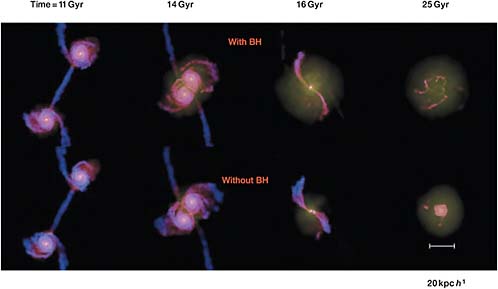
FIGURE 3.17 Snapshots of the time evolution of a merger of two galaxies with (top) and without (bottom) supermassive central black holes illustrate the possible role of active galactic nuclei (AGN) feedback in galaxy formation. The images visualize the projected gas density color-coded by increasing temperature (blue to red). The supermassive black holes accrete from the surrounding gas, undergoing a quasar phase close to the merger event, and the associated feedback energy heats and expels a large fraction of the gas after the major merger. In this simulation, AGN feedback turns the galaxy into a red-and-dead elliptical. SOURCE: Reprinted by permission from Macmillan Publishers Ltd.: Nature, T. Di Matteo, V. Springel, and L. Hernquist, Energy input from quasars regulates the growth and activity of black holes and their host galaxies, Nature 433:604-607, 2005, copyright 2005.
accretion power. In particular, it would be possible to distinguish disk coronae from the X-ray-bright bases of jets.
A complementary survey of time-averaged broad iron lines in fainter AGN will yield the spin distribution function of local SMBHs, a powerful constraint on SMBH evolution models. Furthermore, comparison of spins in radio-loud and radio-quiet subsamples could provide the first direct observational test of whether black hole spin powers jets. These data will also allow a determination of the properties of the disk as a function of black hole mass, spin, accretion rate, and jet power. The technical requirements for this spin survey are similar to those needed for the study of time-variable iron lines. Astro-H will be a first step in this direction, yielding high-quality average spectra of broad iron lines in approximately 20 AGN. It is also essential that improved theoretical models of accretion disks continue to
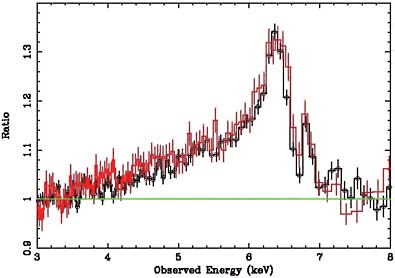
FIGURE 3.18 Broadened iron Kα emission line in the time-averaged X-ray spectrum of the active galaxy MCG-6-30-15, represented as a ratio of the data against the underlying power-law continuum. Shown here are data from X-ray Multi-mirror Mission-Newton (red) and Sukazu (black). This emission line is believed to be produced in the surface layers of the inner accretion disk around the central supermassive black hole (SMBH), with the highly broadened and skewed line profile caused by relativistic Doppler broadening and a strong gravitational redshift. In this galaxy, the extreme line broadening implies that the SMBH must be rapidly rotating. SOURCE: Reproduced with permission from G. Miniutti, A.C. Fabian, N. Anabuki, J. Crummy, Y. Fukazawa, L. Gallo, Y. Haba, et al., Suzaku observations of the hard x-ray variability of MCG-6-30-15: The effects of strong gravity around a Kerr black hole, Publ. Astron. Soc. Japan 59:S315-S325, 2007, copyright 2007, Astronomical Society of Japan.
be developed concurrently. The ability to model thin accretion disks dominated by radiation pressure is a particularly important goal.
The structure of AGN accretion disks and jets can be explored by means of X-ray polarization measurements. Energy-dependent X-ray polarimetry of radio-quiet (disk-dominated) AGN will constrain the geometry of the X-ray-emitting accretion disk corona. The X-ray polarization of blazars will probe the structure of the jet magnetic field. The results obtained with the recently approved Gravity and Extreme Magnetism Small Explorer are expected to motivate further investigations of X-ray polarization, and some other future X-ray missions have additional polarization capabilities.
To understand the details of accretion onto supermassive black holes, jet formation, and energy dissipation, the panel concluded:
-
It is most important to have sensitive X-ray spectroscopy of actively accreting black holes (AGN) to probe accretion disk and jet physics close to the black hole
-
as well as to determine the spin distribution function of the local SMBH population. The effective area should be sufficient to detect the iron Kα emission line on dynamical timescales in a modest sample of the brightest AGN, yielding both spin and mass. In order to disentangle the effects of absorption in AGN spectra, high resolution (R > 2,000) is required. The same capabilities will yield time-averaged line profiles of more than a hundred AGN with sufficient signal-to-noise ratios to derive the black hole spin distribution.
-
It is important to measure X-ray polarization down to a few percent in AGN and blazars to explore disk structure and jet magnetic field geometry.
A major limitation on the understanding of AGN feedback in clusters/groups is ignorance of the dynamical state of the ICM. High-throughput, high-resolution X-ray spectroscopy will reveal bulk motions and turbulence in the ICM, allowing the AGN/ICM coupling to be explored. The dependence of AGN-induced motions on a group or cluster mass scales will be determined, providing a powerful new observational constraint on the mass dependence of SMBH feedback. Astro-H should be able to detect bulk motion in a few nearby clusters with central AGN. A vigorous program of theoretical research on AGN/ICM interactions will be needed in order to interpret these data, including sophisticated simulations of jet-induced feedback and studies of the basic physics of the ICM plasma.
High-resolution time-resolved spectroscopy in the rest-frame UV and X-ray bands will enable the mass, metal, and energy fluxes from quasar winds to be assessed. This is vital for understanding AGN feedback, since such winds are potentially prime sources of feedback energy. Time-resolved spectroscopy is needed to determine the recombination time of the (photoionized) absorbing outflow and hence break the degeneracy that exists in a single spectrum between the distance of the absorbing material and its density. Sufficient spectral resolution is needed to measure wind velocities and ionization states.
Therefore, in order to seek evidence of black hole feedback, the panel concluded:
-
It is most important to measure turbulence and/or bulk flows using X-ray imaging spectroscopy of the ICM of nearby galaxy clusters and groups, with sufficient image quality, field of view, energy resolution, and signal to noise to provide ionization and velocity maps on the scale of the interaction between the AGN outflow (e.g., radio source) and the gas.
-
It is very important to obtain time-resolved spectroscopy of AGN in order to study quasar winds and their possible role in feedback. The Cosmic Origins Spectrograph on HST has the necessary sensitivity in the UV; in X-rays, capabilities beyond XMM-Newton and Chandra are required.
Complementary multiwavelength surveys to perform a census of active and inactive black holes across cosmic time and to track their growth are crucial for determining the numbers and masses of black holes, the prime mode of their energy generation, and the relationship of black hole and galaxy properties. Because a large fraction of black hole growth is obscured by dust and gas, an AGN census must be sensitive to both obscured and unobscured objects. Since no single selection method detects all such AGN, a combination of at least four techniques is needed: (1) wide and deep hard X-ray (E > 10 keV) surveys, because observations in the rest-frame hard X-ray band (E ~ 10-50 keV) are unbiased with respect to column densities up to 3 × 1024 cm2; (2) infrared color and emission line surveys, because the absorbed energy is reprocessed and re-emitted in the IR; (3) sensitive spectroscopic surveys in the rest-frame optical/UV, focusing on detection of high-ionization narrow lines such as O III, O IV, and Ne V, because these are mostly generated in regions outside the obscuring material and their luminosity seems to track the AGN bolometric luminosity; and (4) radio continuum surveys, which are completely insensitive to obscuration and can readily detect jets (which, however, occur in a minority of AGN).
Of these four techniques, the hard X-ray survey is the most important because hard X-rays are most directly connected to the energy-generation mechanism in AGN. The observation of hard X-rays (E >10 keV) unequivocally signals the presence of an AGN, whereas infrared continuum, some optical emission lines, and radio continuum can be produced by, for example, star formation. The panel anticipates major discoveries in this area with the 2011 launch of NuSTAR, a sensitive narrow-field instrument that will find moderate luminosity obscured AGN at z ~ 1. This is analogous to the deep GOODS survey in the optical/IR, which found mainly lower-luminosity galaxies and AGN, and is no substitute for an SDSS-type wide-area survey, which is sensitive to the most-luminous quasar-like objects. To study the full range of galaxies and AGN, NuSTAR must be complemented by a sensitive hard X-ray survey over an appreciable fraction of the sky.
Because of their great sensitivity, infrared and O III surveys can detect large numbers of objects in short observing times over a wide redshift range. Optical spectroscopy can also be used to estimate black hole masses. At present radio surveys go extremely deep, but to understand the survey content, follow-up studies will be needed in the optical and IR bands. Optical and IR follow-up studies will also be useful to estimate black hole masses from broad-line widths.
The panel concluded:
-
It is very important to do complementary multiwavelength surveys to track the growth of black holes across cosmic time. A hard X-ray all-sky survey for AGN is an essential complement to the deep pencil-beam surveys of active galaxies ex-
-
pected from the upcoming NuSTAR Explorer. Long-wavelength IR surveys capture the total energy output, and rest-frame optical spectroscopic surveys allow black hole mass determinations.
Gravitational radiation from merging SMBHs can be detected with a space-based gravitational wave observatory. Although the restricted mass range and the possibility of small-number statistics will prevent a detailed reconstruction of the SMBH merger tree, gravitational radiation results will allow the discrimination of small-seed ![]() and large-seed
and large-seed ![]() scenarios for early SMBH growth and will determine the masses and spins of some objects. It will, however, be impossible to relate these SMBH mergers to the host galaxy properties without finding a significant number of electromagnetic counterparts. On balance, the panel concluded:
scenarios for early SMBH growth and will determine the masses and spins of some objects. It will, however, be impossible to relate these SMBH mergers to the host galaxy properties without finding a significant number of electromagnetic counterparts. On balance, the panel concluded:
-
The search for gravitational radiation from merging supermassive black holes, at lower frequencies than are probed with the Laser Interferometer Gravity Observatory, is very important for an understanding of the buildup of supermassive black holes.
Correlations between the masses of supermassive black holes and the properties of the galaxies that host them are an important fossil of the feedback processes that couple SMBH and galaxy evolution. This is evidenced by the remarkable M-σ relation locally, which was established via the dynamical measurement of the masses of SMBHs in several dozen galaxies. Adaptive optics on ELTs will allow dynamical measurement of SMBH masses in thousands of low-redshift galaxies (including low-mass systems for which current constraints are poor), as well as searches for SMBHs with masses ![]() and for extremely massive SMBHs
and for extremely massive SMBHs ![]()
![]() at any redshift. These new data will yield the intrinsic mass-dependent scatter in the M-σ relation and perhaps its evolution, as well as any dependence on host galaxy morphology, bulge velocity dispersion, or galaxy luminosity. The only other probe of inactive galactic nuclei is the detection of transient events caused by the accretion of stars. Recent UV and soft X-ray studies have found several normal galaxies whose nuclei brightened greatly, presumably due to the tidal disruption of stars. Large time-domain surveys will find many more such objects, allowing the detection of normally quiescent black holes. The panel concluded that, in order to extend the M-σ relation to low-mass local systems and massive high-redshift systems:
at any redshift. These new data will yield the intrinsic mass-dependent scatter in the M-σ relation and perhaps its evolution, as well as any dependence on host galaxy morphology, bulge velocity dispersion, or galaxy luminosity. The only other probe of inactive galactic nuclei is the detection of transient events caused by the accretion of stars. Recent UV and soft X-ray studies have found several normal galaxies whose nuclei brightened greatly, presumably due to the tidal disruption of stars. Large time-domain surveys will find many more such objects, allowing the detection of normally quiescent black holes. The panel concluded that, in order to extend the M-σ relation to low-mass local systems and massive high-redshift systems:
-
It is very important to measure dynamical masses of a thousand or more SMBHs, using spatially resolved spectroscopy with adaptive optics on ELTs. SMBH
-
masses in smaller samples are possible with centimeter-wave maser observations with very long baseline arrays supplemented by large aperture dishes, and/or reverberation mapping of AGN (see the discussion for the first key question).
Finally, the bases of jets can be studied by way of multiwavelength observations of nearby radio galaxies and blazars. Exciting discoveries are just beginning to come from multiwavelength campaigns involving the VLBA, (sub)millimeter very long baseline interferometry (VLBI) observations, and the current generation of ground-based and spaceborne gamma-ray observatories. The observations will show which improvements in spatial resolution and sensitivity are needed for further progress. The panel concluded:
-
Multiwavelength observations of blazars, including ground-based and spaceborne gamma-ray observatories, the VLBA, and millimeter VLBI (and eventually submillimeter VLBI), are important for determining jet composition and constraining formation models.
GCT 4. WHAT WERE THE FIRST OBJECTS TO LIGHT UP THE UNIVERSE, AND WHEN DID THEY DO IT?
-
Where and when did the first objects form?
-
When did the first galaxies emerge, and what were they like?
-
How did these first objects reionize the universe?
Progress to Date
The epoch between the last scattering of the cosmic microwave background radiation, at z ~ 1,100, and the current high-redshift frontier at z ~ 8, where the most distant quasars, GRBs, and galaxies have been observed, remains completely unexplored. This epoch contains the first stars, first galaxies, and first massive black holes. These objects must produce the ionizing photons that led to the reionization of the neutral hydrogen (formed at recombination, z ~ 1,100) in the universe. The formation of the first astrophysical objects and the subsequent epoch of reionization are at the frontiers of astrophysical research in the next decade.
The study of the first objects and the epoch of reionization (Figure 3.19) is an area of discovery, leading into uncharted territory. Theoretical efforts are the only guide to understanding what the first luminous objects were and how they manifested themselves. Rapid progress is being made, and the interplay of theory and observations promise to answer key questions if, in the next decade, a comprehensive array of empirical means to study this epoch are developed.
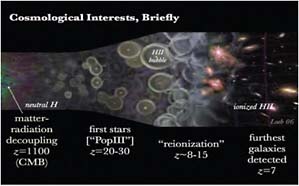
FIGURE 3.19 Cosmic timeline showing the formation of structure in the universe from the Dark Ages (left) to the formation of the first stars, galaxies, and black holes that started the reionization of the intergalactic medium, which is transparent in the present day (right). SOURCE: Courtesy of Abraham Loeb and Jean-Francois Podevin, adapted from Abraham Loeb, The dark ages of the universe, Scientific American 295:46-53, 2006.
GCT Discovery Area—The Epoch of Reionization
The discovery area identified by the Panel on Galaxies Across Cosmic Time is closely entwined with the panel’s fourth key question, What were the first objects to light up the universe, and when did they do it? Originally the panel intended to separate the two, with the fourth key question addressing that part of the early universe for which there is existing knowledge (e.g., objects discovered out to z ~ 8), and the discovery area referring to the less-well-understood part of the epoch of reionization (e.g., collapse of the first H I structures). However, it proved simpler and more straightforward to combine the two; hence this section includes both the focused questions and the broader inquiry appropriate to a discovery area.
Recent years have seen significant progress both in theoretical understanding and in observational probes of this transition epoch in the early universe. Observations of high-redshift quasars have uncovered a number of luminous objects at z ~ 6, the spectra of which imply that the process of reionization was complete by then. There are hints of objects at z ~ 7 and a few candidates at even higher redshifts that have been detected with the aid of gravitational lensing. GRBs have been discovered out to z ~ 8.2. The recent measurements of the optical depth to electron scattering from the Wilkinson Microwave Anisotropy Probe (WMAP) polarization studies suggest that the first sources of light had already significantly reionized the IGM at z > 11. There is no doubt from these observations that the first galaxies and quasars were well in place by z ~ 6 and may have started to appear as early as z ~ 15-20. The actual history of reionization is still highly uncertain (as illustrated in Figure 3.1); Figure 3.20 summarizes current observational constraints on the inferred neutral hydrogen fraction of the IGM.
Theoretical work suggests a general framework for the formation of the first objects: ΛCDM simulations indicate that the first objects formed as early as z ~ 40, out of gas that cooled via molecular hydrogen in the first dark matter halos. Most
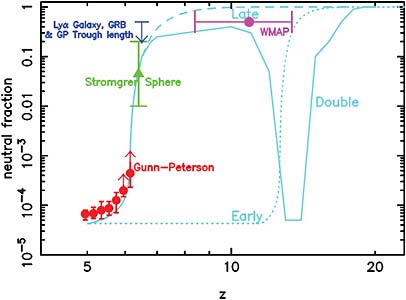
FIGURE 3.20 Current constraints on the volume average neutral fraction of the intergalactic medium versus redshift. The red points indicate measurements based on the highest-redshift quasars. The green triangle shows the constraints from cosmic Strömgren spheres and surfaces around the highest-redshift quasars, and the magenta point indicates the Wilkinson Microwave Anisotropy Probe constraint. The curves show the expectations for different assumptions about early star formation. SOURCE: Adapted from X. Fan, C.L. Carilli, and B. Keating, Observational constraints on cosmic reionization, Annual Review of Astronomy and Astrophysics 44:415-462, 2006.
simulations suggest that the first stars, called Population III, were predominantly very massive; their demise should have created the first black holes. The soft UV and X-rays emitted by these first stars and black holes provided significant feedback to the chemical and thermal state of the IGM by driving expanding ionized H II regions into it (Figure 3.21). These events may have marked the beginning of reionization. Having dissociated the molecular hydrogen, radiative feedback from the first stars led to a second generation of stars and galaxies in which the gas cooled through radiative transitions in atomic hydrogen and helium. The ionized regions surrounding these primordial galaxies grew and merged until they fully overlapped, marking the end of reionization.
It is still very uncertain whether stars were the first significant ionizing sources. An alternative possibility is that a similar fraction of this gas formed massive black holes directly (see Figure 3.21).
Moreover, massive metal-free stars should (in most cases) leave behind stellarmass seed black holes that accrete gas as mini-quasars. Depending on the efficiency with which ionizing photons escape into the IGM, the first halos might blow away their gas after a single episode of star formation and might not form any stars until
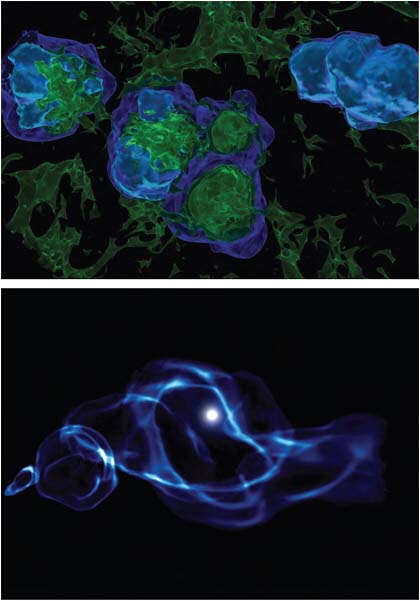
FIGURE 3.21 Computer simulations of first stars and black holes illustrating the initial steps in the process of reionization. Top: Ionizing radiation emanates from the first massive stars that form inside dark matter mini-halos, creating ionized bubbles (blue) interspersed with regions of high molecular abundance (green), both embedded in the still-neutral cosmic gas. The large residual free-electron fraction inside relic H II regions, left behind after the central star has died, rapidly catalyzes the formation of molecules. Simulations were performed by Bromm et al. (2009), and visualization is courtesy of the Texas Advanced Computing Center. Bottom: Simulation showing the X-rays produced by a black hole (white), created when a first-generation star collapses, and their ionizing effect on nearby gas (blue). SOURCE: Top: Reprinted by permission from Macmillan Publishers Ltd.: Nature, V. Bromm, N. Yoshida, L. Hernquist and C.F. McKee, Formation of the first stars and galaxies, Nature 459:49-54, 2009, copyright 2009. Bottom: Courtesy of KIPAC/SLAC/M. Alvarez, T. Abel, and J. Wise.
deeper potential wells are formed. In general, several feedback processes are likely to be important at these stages, from internal feedback (e.g., due to the presence of supernovae) to external global feedback provided by the UV and X-ray background produced by the first sources. Numerical simulations are the most promising way to address many of these issues; however, accommodating the dynamic range required to resolve the small-scale physics in mini-halos and the large cosmological volumes needed to capture the emergence of rare density peaks is extremely challenging, especially since radiative transfer effects need to be included.
Steps for the Next Decade
Existing observations provide only a preliminary glimpse into the late stages of the epoch of reionization (Figure 3.22). Because this is an area of discovery, it is difficult to outline specific future science programs, and the panel was guided primarily by uncertain theoretical predictions. The first stars should have been essentially metal-free and extremely massive (M > 100 MSun), with a radiation field that is very efficient at ionizing hydrogen and helium. Thus, direct observation of the first stars depends on the detection of the rest-frame UV continuum and line emission, particularly the He II (1,640 Å) and Ly-α emission lines, which for redshifts z < 11 will appear in the J band. The ability to detect the first stars depends critically on the physics of star formation in a metal-free environment (e.g., initial mass function, star-formation efficiency, etc.) and the extent to which these first objects are clustered. While individual stars will be much too faint to be detected directly with JWST or an ELT, if the first stars formed in larger aggregates then the resulting H II regions are expected to have line fluxes approximately 10−21 erg cm−2 s−1.3 The likeliest way forward is to use JWST deep fields, especially with the aid of gravitational lensing, to find the earliest stars and protogalaxies. Simply finding the first objects is not enough: to probe the astrophysics of the first objects requires follow-up near-IR spectroscopy (R ~ 5,000) and to determine the properties of the IGM requires absorption-line spectroscopy.
The first explosions are key probes of the beginning of the epoch of reionization. Detection of transient objects during this epoch will allow the study of the intervening IGM through absorption spectroscopy. GRBs can be used as probes of the high-redshift universe, provided that several dozen with z > 8 are detected; this would take 2 to 5 years for a facility that detects GRBs at 10 times the rate that Swift does. It is critical to understand stellar astrophysics in metal-free conditions in order to predict the properties of the first supernovae. A Type IIn supernova should
|
3 |
See Astronomy and Astrophysics Advisory Committee, GSMT and JWST: Looking Back to the Future of the Universe, available at http://www.nsf.gov/mps/ast/aaac/reports/gsmt-jwst_synergy_combined.pdf. Accessed February 2010. |
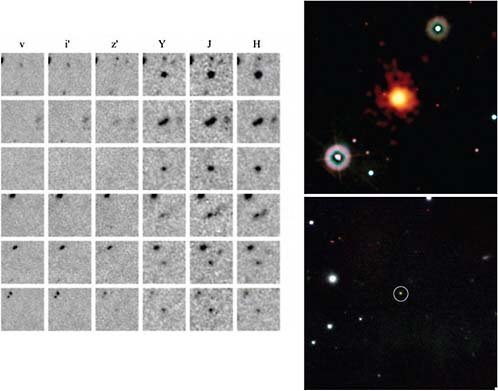
FIGURE 3.22 Left: Candidate redshift z ~ 7 galaxies identified by the “dropout” technique whereby each object is detected in the near infrared (J and H bands) but not at optical wavelengths (viz bands). The goal for the next decade is to find galaxies at even higher redshifts, confirm them spectroscopically, and study their chemical composition to identify primordial stellar populations. Top right: Swift ultraviolet/X-ray image (orange, red) of a gamma-ray burst at redshift z ~ 8.2, assuming the extremely red color in the optical/infrared image (bottom right) is due to the Lyman break at rest-frame 912 Å. This is the highest redshift cosmic explosion detected to date. No visible or ultraviolet light (green, blue) was detected at the position of the burst, but near-infrared emission was detected with the United Kingdom Infrared Telescope Facility and (bottom right) the Gemini North telescope. More such events, and more distant ones, will be visible with sensitive wide-field gamma-ray satellites and prompt follow-up observations in the near-infrared and optical. SOURCE: Left: R.J. Bouwens, G.D Illingworth, M. Franx, and H. Ford, z ~ 7-10 galaxies in the HUDF and GOODS fields: UV luminosity functions, Astrophysical Journal 686(1):230-250, 2008, reproduced by permission of the AAS. Top right: Courtesy of NASA/Swift/Stefan Immler. Bottom right: Courtesy of Gemini Observatory/NSF/AURA/D. Fox, A. Cucchiara (Pennsylvania State University), and E. Berger (Harvard University).
have a rest-frame UV magnitude of M ~ −21, giving an apparent magnitude of 27 at z ~ 6. More distant supernovae would be correspondingly fainter. Confirmation of the brighter events at the end of reionization should be possible with the current generation of 10-meter telescopes, but more distant sources require an ELT.
To find and characterize the first-generation aggregates of stars, the panel concluded:
-
It is most important to use JWST to make deep surveys, followed up with near-IR spectroscopy on an ELT.
-
It is very important to develop a next-generation GRB observatory to search for the first explosions, with an order-of-magnitude-greater GRB detection rate than is possible with Swift, augmented by a rapid follow-up capability for infrared spectroscopy of faint objects.
-
It is very important to do time-domain surveys to identify the first stars from their supernova or hypernova explosions.
Ionization of the neutral IGM during the epoch of reionization creates bubbles that should correlate with the location of the first sources. These bubbles can be detected by means of fluctuations in the brightness temperature of the 21-cm line of H I; because the universe is nearly transparent at these frequencies, the 21-cm line should be an outstanding probe of the entire history of reionization. At high redshift, the 21-cm emission should display angular as well as frequency structure due to inhomogeneities in the gas density field, H II fraction, and H I spin temperature. This prospect has already motivated the design and construction of arrays of low-frequency radio telescopes (e.g., LOFAR, MWA) that aim to search for this signal from z ~ 6-15, redshifted to wavelengths of approximately 1.5 to 4 meters. Ultimately, it will be possible to map the entire history of reionization by way of an all-sky map of redshifted 21-cm emission.
Absorption-line spectroscopy along sight lines toward the first objects—be they stars, GRBs, or supernovae—will allow the detection of the presence of metals and the ionization level throughout the epoch of reionization. Such observations necessarily require the collecting area and spectroscopic capability of an ELT, which can determine redshifts, stellar masses, and chemical compositions in early galaxies, quasars, and transient events. Detection of ultralow abundances of heavy elements—the definitive indication of the first generation of stars and galaxies—should be feasible within the next decade.
It is also desirable to measure the mean fraction of neutral hydrogen with independent probes. The WMAP data were used to derive the first constraints on the redshift range of the epoch of reionization based on E-mode polarization
measurements. The Planck satellite will substantially improve on these results. The Planck results might motivate additional measurements with a follow-up mission.
The panel concluded that to explore the discovery area of the epoch of reionization:
-
It is most important to develop new capabilities to observe redshifted 21-cm H I emission, building on the legacy of current projects and increasing sensitivity and spatial resolution to characterize the topology of the gas at reionization.
-
It is very important to do near-infrared absorption-line spectroscopy with JWST, ELTs, and 10-meter-class telescopes to probe the conditions of the IGM during the epoch of reionization.
-
It is important to measure the CMB E-mode polarization with Planck and possibly follow-on missions.
Although this discussion has so far focused on the first objects, it is very important to find and identify objects residing in the later stages of the epoch of reionization, including radio-loud AGN, quasars, galaxies, supernovae, and GRBs. These populations connect in a directly observable way to the universe today and thus hold the key to a full understanding of its evolution. There is tremendous promise in high-frequency (>30 GHz) searches for CO in the high-redshift universe with both the EVLA and future radio facilities. Cooling by means of the C II and O I fine structure lines might be detectable if metal enrichment occurs early enough. The panel concluded:
-
It is very important to do multiwavelength surveys to detect galaxies, quasars, and GRBs residing in the late stages of reionization at 6 < z < 8, including near-infrared surveys for galaxies and quasars, hard X-ray or gamma-ray monitors for GRBs, and time-variability surveys for supernovae or hypernovae.
-
It is important for ALMA to have the capability to search for C II and O I fine structure line emission at redshifts z > 6.
THEORY AND LABORATORY ASTROPHYSICS: THE NEXT DECADE
Underlying all of astronomy and astrophysics is critical work in theory and other intellectual infrastructure, such as laboratory astrophysics. Theory is at the heart of astronomical inference, connecting observations to underlying physics within the context of a cohesive physical model. The past decade has seen great advances in theoretical aspects of galaxy formation and black hole astrophysics, particularly in the computational arena driven by technological advances. Theory has become more interconnected with data as the fundamental physical processes are better understood and as models are placed within the context of the overall
cosmological paradigm. Many areas are now driven by theoretical goals, such as testing the structure of halos predicted by simulations, observing the cold accretion predicted to be a main channel for supplying galaxies with fuel for star formation, and testing whether jets are powered by black hole spin.
To understand our universe better, to reap the full value of new observational capabilities, and to guide the next observations, investments should be made in the following theoretical areas:
-
Cosmological context. To compare ΛCDM predictions with surveys and understand the connections among galaxies, intergalactic gas, and large-scale structure require hydrodynamical simulations within a hierarchical structure-formation context. The key challenge is to expand the dynamic range of current simulations to study detailed galaxy and cluster assembly within a representative volume, for which developing new algorithms, improving subgrid physics models, and taking advantage of new technologies will be crucial.
-
Galactic flows and feedback. Studies of galaxy formation require understanding accretion and feedback processes, which are central to galaxy assembly. A key issue here is to properly understand two-phase interfaces and instabilities that occur during the motion of gas through ambient media of strongly differing temperatures and densities, and how energy is exchanged and released across such interfaces (e.g., mixing processes). Understanding the injection of energy, momentum, and relativistic particles into ambient gas (i.e., feedback) will require simulations of MHD turbulence, with accurate treatment of transport processes such as viscosity and heat conduction.
-
Magnetohydrodynamics and plasma physics. Studies of accretion disks, jets, and their interactions with ambient plasma require a better understanding of how magnetic fields channel and transport energy over a large dynamic range. Solving some of the key questions will require a better understanding of particle processes such as magnetic reconnection, particle acceleration, and cosmic-ray transport. These processes will have to be incorporated into the next generation of codes in a physically realistic way.
-
Radiation processes. Calculations incorporating radiative transfer are critical for studying the epoch of reionization, the escape of ionizing and Ly-α radiation from galaxies, and the evolution of the IGM. The challenge arises in coupling such models to dynamical galaxy-formation simulations, to understand fully how radiation interacts with the highly clumpy and asymmetric gas distribution. Models of jets and accretion disks must include nonthermal radiation processes such as synchrotron radiation and inverse Compton scattering in order to compute spectra and must include radiation hydrodynamics to capture disk structure accurately.
Addressing these questions should be done using a tiered approach, with an emphasis on computational work that takes advantage of rapidly developing technologies. Small teams led by individuals are in a good position to push the frontiers of algorithms and new computing architectures. Medium-size groups of several experts are important to make coherent and concerted progress on key numerical issues outlined above. Large, heroic simulations that push the limits of available technology are critical to drive forefront work; these are best facilitated by large computing centers. All of these areas are informed by analytic theory, which is crucial for providing the basic physical underpinnings for more complex models. Together these aspects are fundamentally important for making progress toward understanding the universe, and the galaxies, clusters, black holes, gas, and dark matter within it.
Laboratory astrophysics is clearly important to understanding galaxies, black holes, and clusters across cosmic time. For example, the details of absorption by dust are not understood, even though most cosmic objects are substantially impacted by dust. Similarly, still lacking are important cross sections for hot gas cooler than 4 million degrees, which is significant in clusters and the IGM. Scientists are not sure of recombination rates that determine ionization equilibria. Spectral features at millimeter to infrared wavelengths are especially poorly known and difficult to calculate, as they arise in molecules and clusters of atoms; ALMA will see a forest of lines that, without new laboratory measurements, will be difficult to interpret. Although the lack of laboratory measurements may not today be a limiting factor in the studies outlined earlier in this report, it may well become the limiting factor as the data improve.
CONCLUSION
We now stand at the threshold of being able to observe the full history of cosmic structure, across all mass scales, from earliest times to the present day. With a judiciously chosen set of new facilities, instruments, and observing strategies, we can learn how galaxies, clusters, and black holes form, evolve, interact, and influence each other, to a degree of accuracy undreamed of just 20 years ago. This unprecedented wealth of data should be accompanied by a concomitant increase in understanding through the development of new analytic and computational theoretical tools. The past decade has brought dramatic advances in cosmology and an emerging picture of the growth of galaxies and black holes across the immensity of cosmic time. The next decade will open up the entire universe to detailed study and will revolutionize our understanding of the processes by which the observable cosmos came to be.

